5CO02 Report: Evidence-based Practice, Decision-Making, Ethics
VerifiedAdded on 2023/02/07
|17
|5398
|49
Report
AI Summary
This report delves into the principles of evidence-based practice within a management context, encompassing various facets of organizational operations and decision-making processes. It initiates with an exploration of evidence-based practices for informed decision-making, emphasizing the significance of data evaluation in guiding actions and strategic goals. The report then progresses to analyze organizational environments utilizing tools such as balanced scorecards and Porter's Five Forces, providing insights into competitive dynamics and performance measurement. Furthermore, it examines the concept of critical thinking and its influence on decision-making processes. The report also explores the range of decision-making processes to identify potential solutions and the impact of ethical perspectives on these choices. The report then delves into measuring financial and non-financial performance, exploring how people practices add value to an organization. Using data and analysis tools, the report makes justified recommendations based on the evaluation of the benefits, risks, and financial implications of potential solutions for people practice issues.
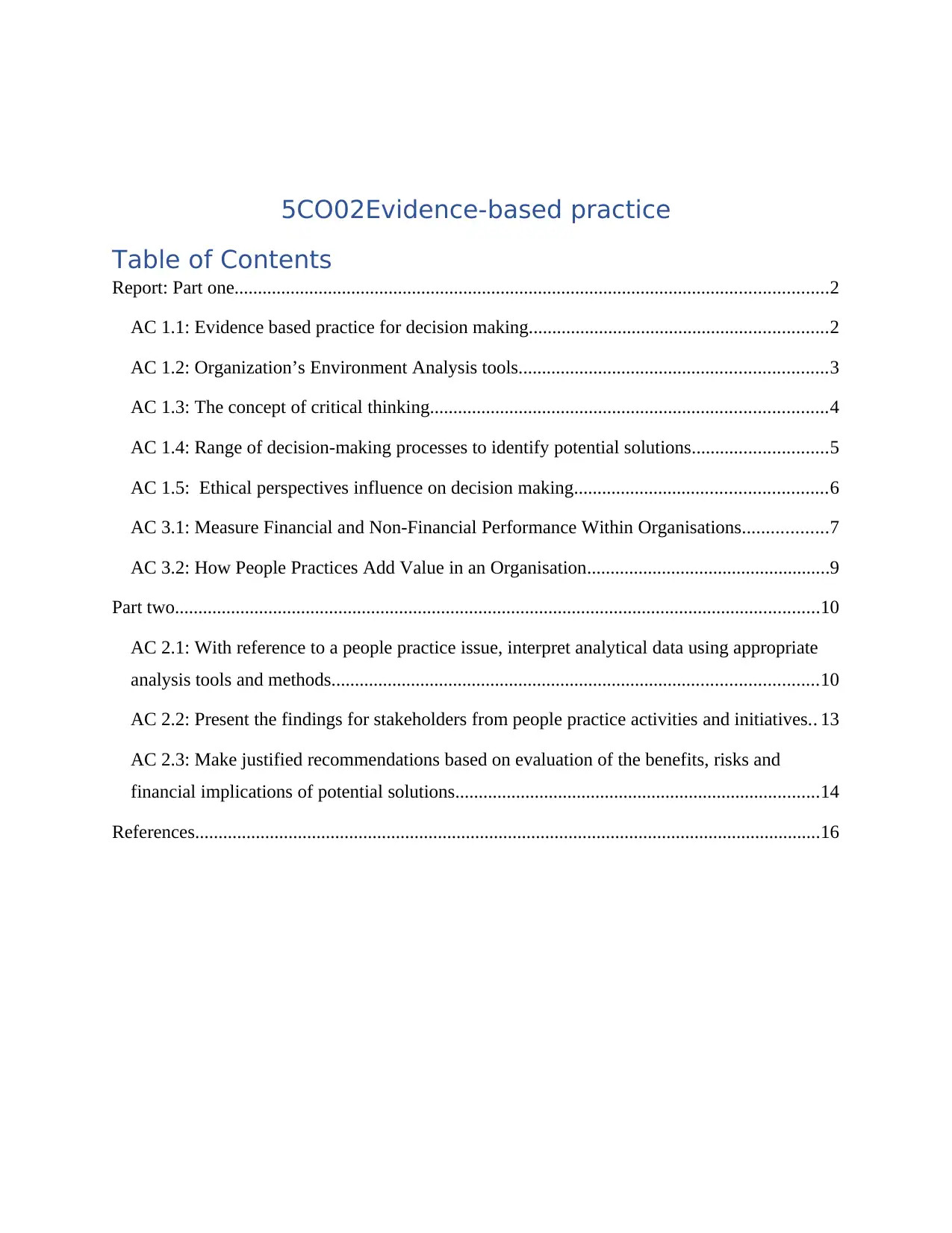
5CO02Evidence-based practice
Table of Contents
Report: Part one...............................................................................................................................2
AC 1.1: Evidence based practice for decision making................................................................2
AC 1.2: Organization’s Environment Analysis tools..................................................................3
AC 1.3: The concept of critical thinking.....................................................................................4
AC 1.4: Range of decision-making processes to identify potential solutions.............................5
AC 1.5: Ethical perspectives influence on decision making......................................................6
AC 3.1: Measure Financial and Non-Financial Performance Within Organisations..................7
AC 3.2: How People Practices Add Value in an Organisation....................................................9
Part two..........................................................................................................................................10
AC 2.1: With reference to a people practice issue, interpret analytical data using appropriate
analysis tools and methods........................................................................................................10
AC 2.2: Present the findings for stakeholders from people practice activities and initiatives.. 13
AC 2.3: Make justified recommendations based on evaluation of the benefits, risks and
financial implications of potential solutions..............................................................................14
References......................................................................................................................................16
Table of Contents
Report: Part one...............................................................................................................................2
AC 1.1: Evidence based practice for decision making................................................................2
AC 1.2: Organization’s Environment Analysis tools..................................................................3
AC 1.3: The concept of critical thinking.....................................................................................4
AC 1.4: Range of decision-making processes to identify potential solutions.............................5
AC 1.5: Ethical perspectives influence on decision making......................................................6
AC 3.1: Measure Financial and Non-Financial Performance Within Organisations..................7
AC 3.2: How People Practices Add Value in an Organisation....................................................9
Part two..........................................................................................................................................10
AC 2.1: With reference to a people practice issue, interpret analytical data using appropriate
analysis tools and methods........................................................................................................10
AC 2.2: Present the findings for stakeholders from people practice activities and initiatives.. 13
AC 2.3: Make justified recommendations based on evaluation of the benefits, risks and
financial implications of potential solutions..............................................................................14
References......................................................................................................................................16
Secure Best Marks with AI Grader
Need help grading? Try our AI Grader for instant feedback on your assignments.
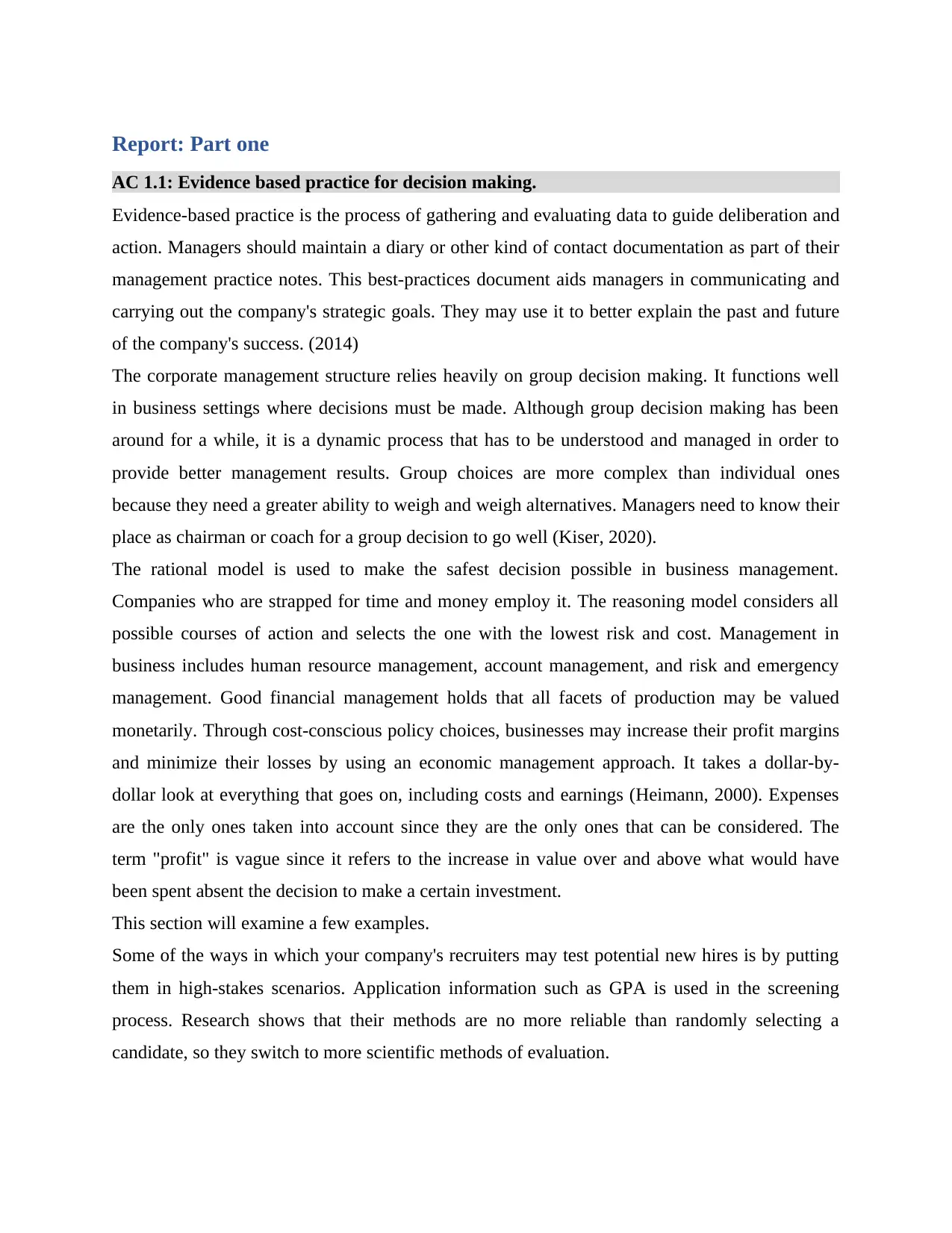
Report: Part one
AC 1.1: Evidence based practice for decision making.
Evidence-based practice is the process of gathering and evaluating data to guide deliberation and
action. Managers should maintain a diary or other kind of contact documentation as part of their
management practice notes. This best-practices document aids managers in communicating and
carrying out the company's strategic goals. They may use it to better explain the past and future
of the company's success. (2014)
The corporate management structure relies heavily on group decision making. It functions well
in business settings where decisions must be made. Although group decision making has been
around for a while, it is a dynamic process that has to be understood and managed in order to
provide better management results. Group choices are more complex than individual ones
because they need a greater ability to weigh and weigh alternatives. Managers need to know their
place as chairman or coach for a group decision to go well (Kiser, 2020).
The rational model is used to make the safest decision possible in business management.
Companies who are strapped for time and money employ it. The reasoning model considers all
possible courses of action and selects the one with the lowest risk and cost. Management in
business includes human resource management, account management, and risk and emergency
management. Good financial management holds that all facets of production may be valued
monetarily. Through cost-conscious policy choices, businesses may increase their profit margins
and minimize their losses by using an economic management approach. It takes a dollar-by-
dollar look at everything that goes on, including costs and earnings (Heimann, 2000). Expenses
are the only ones taken into account since they are the only ones that can be considered. The
term "profit" is vague since it refers to the increase in value over and above what would have
been spent absent the decision to make a certain investment.
This section will examine a few examples.
Some of the ways in which your company's recruiters may test potential new hires is by putting
them in high-stakes scenarios. Application information such as GPA is used in the screening
process. Research shows that their methods are no more reliable than randomly selecting a
candidate, so they switch to more scientific methods of evaluation.
AC 1.1: Evidence based practice for decision making.
Evidence-based practice is the process of gathering and evaluating data to guide deliberation and
action. Managers should maintain a diary or other kind of contact documentation as part of their
management practice notes. This best-practices document aids managers in communicating and
carrying out the company's strategic goals. They may use it to better explain the past and future
of the company's success. (2014)
The corporate management structure relies heavily on group decision making. It functions well
in business settings where decisions must be made. Although group decision making has been
around for a while, it is a dynamic process that has to be understood and managed in order to
provide better management results. Group choices are more complex than individual ones
because they need a greater ability to weigh and weigh alternatives. Managers need to know their
place as chairman or coach for a group decision to go well (Kiser, 2020).
The rational model is used to make the safest decision possible in business management.
Companies who are strapped for time and money employ it. The reasoning model considers all
possible courses of action and selects the one with the lowest risk and cost. Management in
business includes human resource management, account management, and risk and emergency
management. Good financial management holds that all facets of production may be valued
monetarily. Through cost-conscious policy choices, businesses may increase their profit margins
and minimize their losses by using an economic management approach. It takes a dollar-by-
dollar look at everything that goes on, including costs and earnings (Heimann, 2000). Expenses
are the only ones taken into account since they are the only ones that can be considered. The
term "profit" is vague since it refers to the increase in value over and above what would have
been spent absent the decision to make a certain investment.
This section will examine a few examples.
Some of the ways in which your company's recruiters may test potential new hires is by putting
them in high-stakes scenarios. Application information such as GPA is used in the screening
process. Research shows that their methods are no more reliable than randomly selecting a
candidate, so they switch to more scientific methods of evaluation.
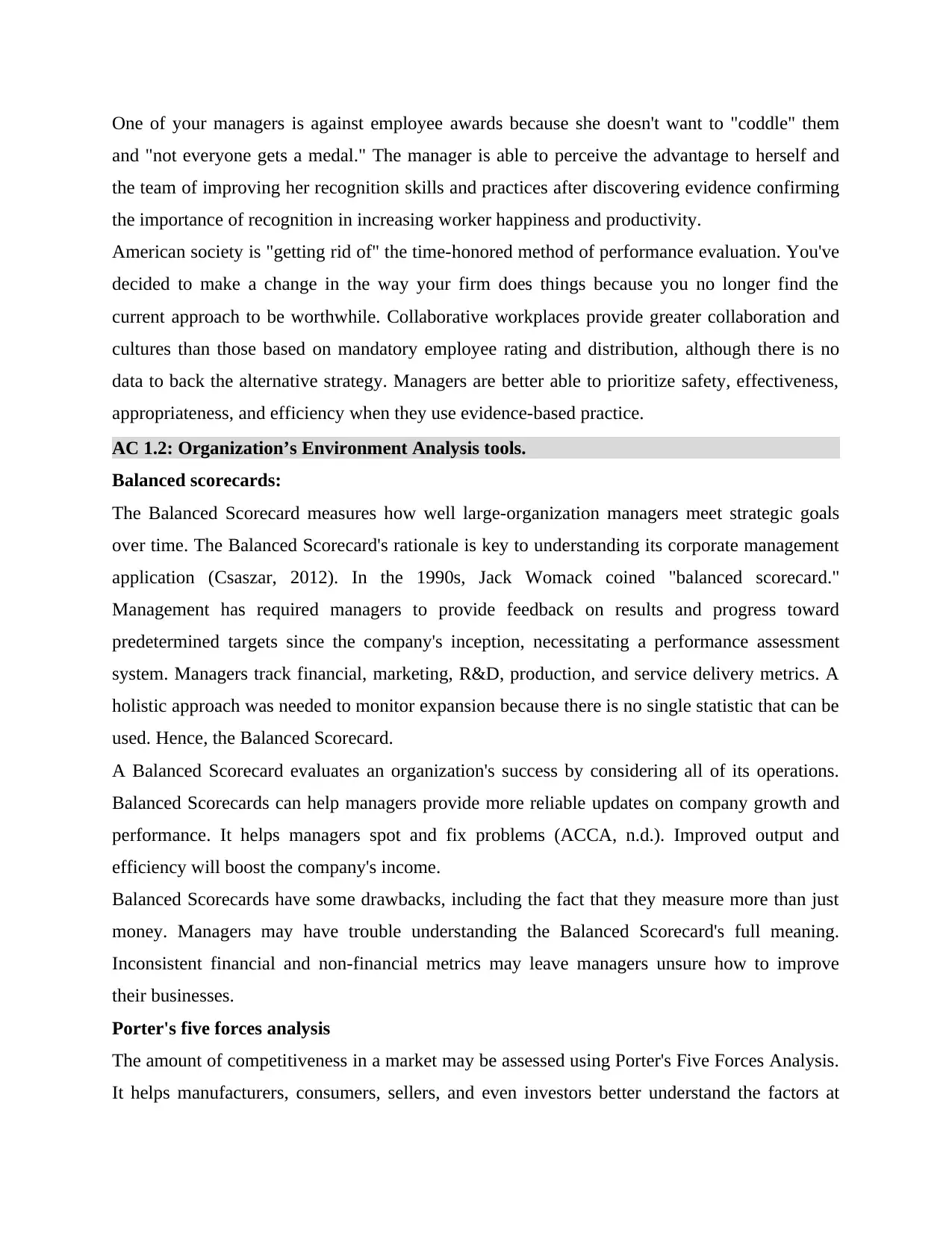
One of your managers is against employee awards because she doesn't want to "coddle" them
and "not everyone gets a medal." The manager is able to perceive the advantage to herself and
the team of improving her recognition skills and practices after discovering evidence confirming
the importance of recognition in increasing worker happiness and productivity.
American society is "getting rid of" the time-honored method of performance evaluation. You've
decided to make a change in the way your firm does things because you no longer find the
current approach to be worthwhile. Collaborative workplaces provide greater collaboration and
cultures than those based on mandatory employee rating and distribution, although there is no
data to back the alternative strategy. Managers are better able to prioritize safety, effectiveness,
appropriateness, and efficiency when they use evidence-based practice.
AC 1.2: Organization’s Environment Analysis tools.
Balanced scorecards:
The Balanced Scorecard measures how well large-organization managers meet strategic goals
over time. The Balanced Scorecard's rationale is key to understanding its corporate management
application (Csaszar, 2012). In the 1990s, Jack Womack coined "balanced scorecard."
Management has required managers to provide feedback on results and progress toward
predetermined targets since the company's inception, necessitating a performance assessment
system. Managers track financial, marketing, R&D, production, and service delivery metrics. A
holistic approach was needed to monitor expansion because there is no single statistic that can be
used. Hence, the Balanced Scorecard.
A Balanced Scorecard evaluates an organization's success by considering all of its operations.
Balanced Scorecards can help managers provide more reliable updates on company growth and
performance. It helps managers spot and fix problems (ACCA, n.d.). Improved output and
efficiency will boost the company's income.
Balanced Scorecards have some drawbacks, including the fact that they measure more than just
money. Managers may have trouble understanding the Balanced Scorecard's full meaning.
Inconsistent financial and non-financial metrics may leave managers unsure how to improve
their businesses.
Porter's five forces analysis
The amount of competitiveness in a market may be assessed using Porter's Five Forces Analysis.
It helps manufacturers, consumers, sellers, and even investors better understand the factors at
and "not everyone gets a medal." The manager is able to perceive the advantage to herself and
the team of improving her recognition skills and practices after discovering evidence confirming
the importance of recognition in increasing worker happiness and productivity.
American society is "getting rid of" the time-honored method of performance evaluation. You've
decided to make a change in the way your firm does things because you no longer find the
current approach to be worthwhile. Collaborative workplaces provide greater collaboration and
cultures than those based on mandatory employee rating and distribution, although there is no
data to back the alternative strategy. Managers are better able to prioritize safety, effectiveness,
appropriateness, and efficiency when they use evidence-based practice.
AC 1.2: Organization’s Environment Analysis tools.
Balanced scorecards:
The Balanced Scorecard measures how well large-organization managers meet strategic goals
over time. The Balanced Scorecard's rationale is key to understanding its corporate management
application (Csaszar, 2012). In the 1990s, Jack Womack coined "balanced scorecard."
Management has required managers to provide feedback on results and progress toward
predetermined targets since the company's inception, necessitating a performance assessment
system. Managers track financial, marketing, R&D, production, and service delivery metrics. A
holistic approach was needed to monitor expansion because there is no single statistic that can be
used. Hence, the Balanced Scorecard.
A Balanced Scorecard evaluates an organization's success by considering all of its operations.
Balanced Scorecards can help managers provide more reliable updates on company growth and
performance. It helps managers spot and fix problems (ACCA, n.d.). Improved output and
efficiency will boost the company's income.
Balanced Scorecards have some drawbacks, including the fact that they measure more than just
money. Managers may have trouble understanding the Balanced Scorecard's full meaning.
Inconsistent financial and non-financial metrics may leave managers unsure how to improve
their businesses.
Porter's five forces analysis
The amount of competitiveness in a market may be assessed using Porter's Five Forces Analysis.
It helps manufacturers, consumers, sellers, and even investors better understand the factors at
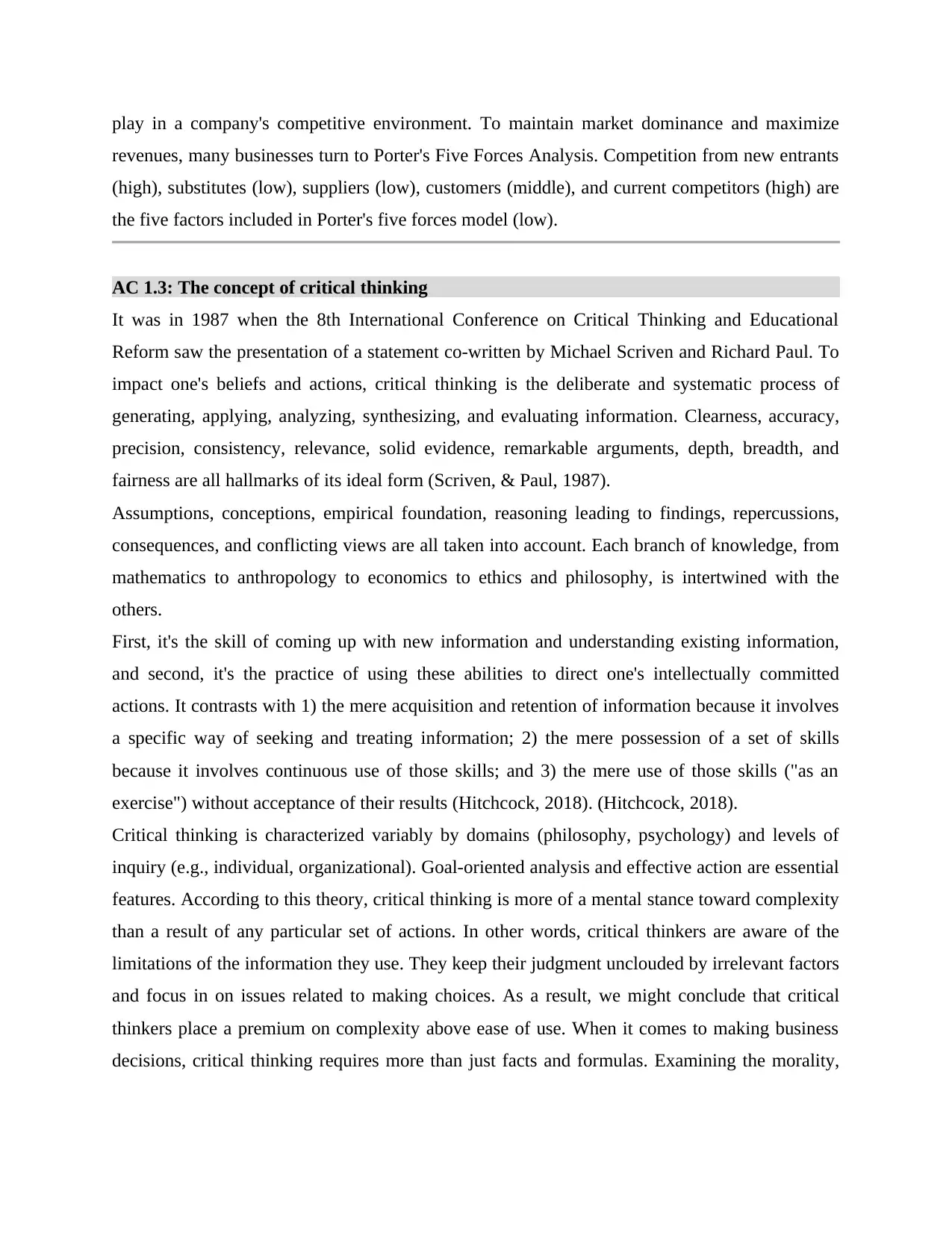
play in a company's competitive environment. To maintain market dominance and maximize
revenues, many businesses turn to Porter's Five Forces Analysis. Competition from new entrants
(high), substitutes (low), suppliers (low), customers (middle), and current competitors (high) are
the five factors included in Porter's five forces model (low).
AC 1.3: The concept of critical thinking
It was in 1987 when the 8th International Conference on Critical Thinking and Educational
Reform saw the presentation of a statement co-written by Michael Scriven and Richard Paul. To
impact one's beliefs and actions, critical thinking is the deliberate and systematic process of
generating, applying, analyzing, synthesizing, and evaluating information. Clearness, accuracy,
precision, consistency, relevance, solid evidence, remarkable arguments, depth, breadth, and
fairness are all hallmarks of its ideal form (Scriven, & Paul, 1987).
Assumptions, conceptions, empirical foundation, reasoning leading to findings, repercussions,
consequences, and conflicting views are all taken into account. Each branch of knowledge, from
mathematics to anthropology to economics to ethics and philosophy, is intertwined with the
others.
First, it's the skill of coming up with new information and understanding existing information,
and second, it's the practice of using these abilities to direct one's intellectually committed
actions. It contrasts with 1) the mere acquisition and retention of information because it involves
a specific way of seeking and treating information; 2) the mere possession of a set of skills
because it involves continuous use of those skills; and 3) the mere use of those skills ("as an
exercise") without acceptance of their results (Hitchcock, 2018). (Hitchcock, 2018).
Critical thinking is characterized variably by domains (philosophy, psychology) and levels of
inquiry (e.g., individual, organizational). Goal-oriented analysis and effective action are essential
features. According to this theory, critical thinking is more of a mental stance toward complexity
than a result of any particular set of actions. In other words, critical thinkers are aware of the
limitations of the information they use. They keep their judgment unclouded by irrelevant factors
and focus in on issues related to making choices. As a result, we might conclude that critical
thinkers place a premium on complexity above ease of use. When it comes to making business
decisions, critical thinking requires more than just facts and formulas. Examining the morality,
revenues, many businesses turn to Porter's Five Forces Analysis. Competition from new entrants
(high), substitutes (low), suppliers (low), customers (middle), and current competitors (high) are
the five factors included in Porter's five forces model (low).
AC 1.3: The concept of critical thinking
It was in 1987 when the 8th International Conference on Critical Thinking and Educational
Reform saw the presentation of a statement co-written by Michael Scriven and Richard Paul. To
impact one's beliefs and actions, critical thinking is the deliberate and systematic process of
generating, applying, analyzing, synthesizing, and evaluating information. Clearness, accuracy,
precision, consistency, relevance, solid evidence, remarkable arguments, depth, breadth, and
fairness are all hallmarks of its ideal form (Scriven, & Paul, 1987).
Assumptions, conceptions, empirical foundation, reasoning leading to findings, repercussions,
consequences, and conflicting views are all taken into account. Each branch of knowledge, from
mathematics to anthropology to economics to ethics and philosophy, is intertwined with the
others.
First, it's the skill of coming up with new information and understanding existing information,
and second, it's the practice of using these abilities to direct one's intellectually committed
actions. It contrasts with 1) the mere acquisition and retention of information because it involves
a specific way of seeking and treating information; 2) the mere possession of a set of skills
because it involves continuous use of those skills; and 3) the mere use of those skills ("as an
exercise") without acceptance of their results (Hitchcock, 2018). (Hitchcock, 2018).
Critical thinking is characterized variably by domains (philosophy, psychology) and levels of
inquiry (e.g., individual, organizational). Goal-oriented analysis and effective action are essential
features. According to this theory, critical thinking is more of a mental stance toward complexity
than a result of any particular set of actions. In other words, critical thinkers are aware of the
limitations of the information they use. They keep their judgment unclouded by irrelevant factors
and focus in on issues related to making choices. As a result, we might conclude that critical
thinkers place a premium on complexity above ease of use. When it comes to making business
decisions, critical thinking requires more than just facts and formulas. Examining the morality,
Secure Best Marks with AI Grader
Need help grading? Try our AI Grader for instant feedback on your assignments.
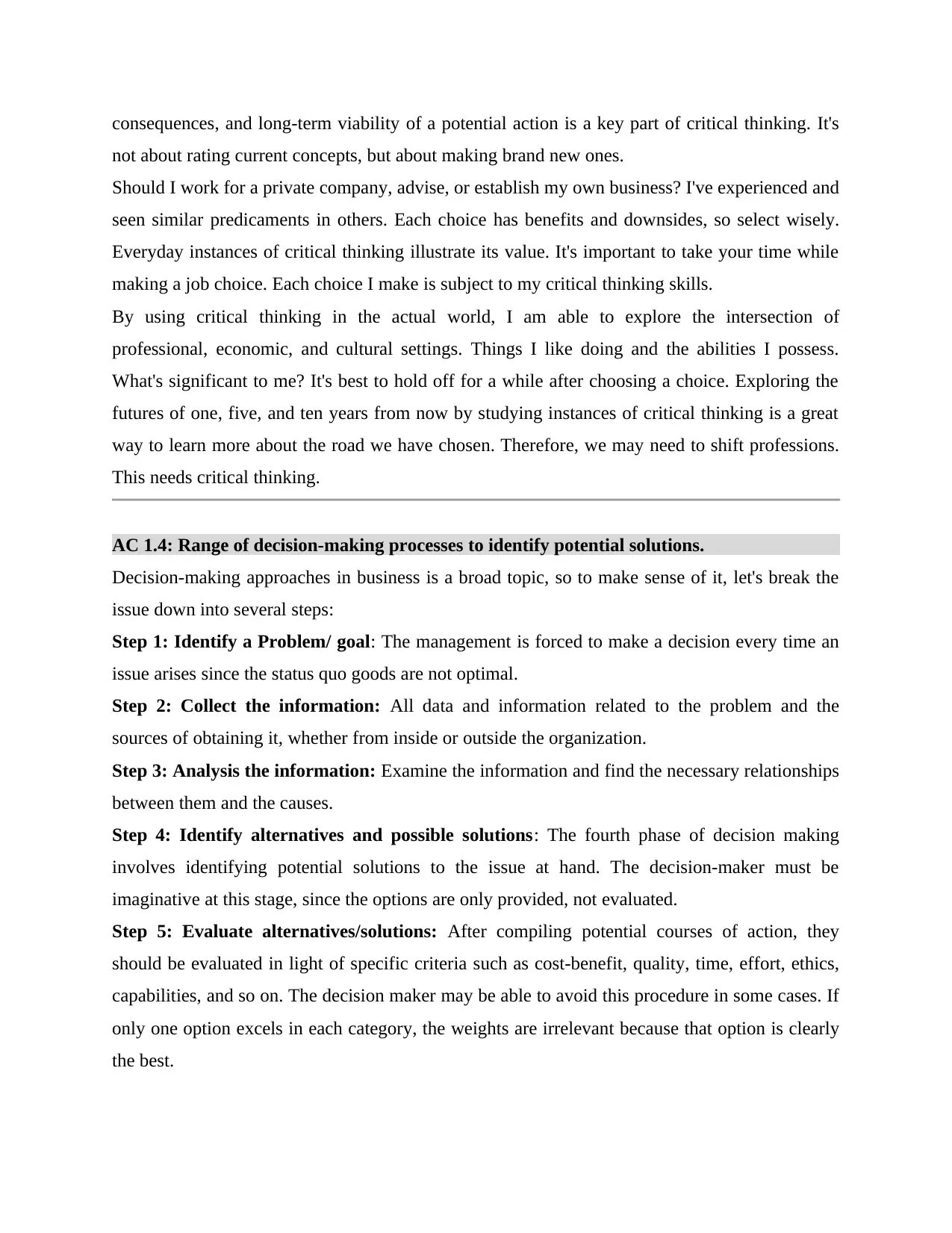
consequences, and long-term viability of a potential action is a key part of critical thinking. It's
not about rating current concepts, but about making brand new ones.
Should I work for a private company, advise, or establish my own business? I've experienced and
seen similar predicaments in others. Each choice has benefits and downsides, so select wisely.
Everyday instances of critical thinking illustrate its value. It's important to take your time while
making a job choice. Each choice I make is subject to my critical thinking skills.
By using critical thinking in the actual world, I am able to explore the intersection of
professional, economic, and cultural settings. Things I like doing and the abilities I possess.
What's significant to me? It's best to hold off for a while after choosing a choice. Exploring the
futures of one, five, and ten years from now by studying instances of critical thinking is a great
way to learn more about the road we have chosen. Therefore, we may need to shift professions.
This needs critical thinking.
AC 1.4: Range of decision-making processes to identify potential solutions.
Decision-making approaches in business is a broad topic, so to make sense of it, let's break the
issue down into several steps:
Step 1: Identify a Problem/ goal: The management is forced to make a decision every time an
issue arises since the status quo goods are not optimal.
Step 2: Collect the information: All data and information related to the problem and the
sources of obtaining it, whether from inside or outside the organization.
Step 3: Analysis the information: Examine the information and find the necessary relationships
between them and the causes.
Step 4: Identify alternatives and possible solutions: The fourth phase of decision making
involves identifying potential solutions to the issue at hand. The decision-maker must be
imaginative at this stage, since the options are only provided, not evaluated.
Step 5: Evaluate alternatives/solutions: After compiling potential courses of action, they
should be evaluated in light of specific criteria such as cost-benefit, quality, time, effort, ethics,
capabilities, and so on. The decision maker may be able to avoid this procedure in some cases. If
only one option excels in each category, the weights are irrelevant because that option is clearly
the best.
not about rating current concepts, but about making brand new ones.
Should I work for a private company, advise, or establish my own business? I've experienced and
seen similar predicaments in others. Each choice has benefits and downsides, so select wisely.
Everyday instances of critical thinking illustrate its value. It's important to take your time while
making a job choice. Each choice I make is subject to my critical thinking skills.
By using critical thinking in the actual world, I am able to explore the intersection of
professional, economic, and cultural settings. Things I like doing and the abilities I possess.
What's significant to me? It's best to hold off for a while after choosing a choice. Exploring the
futures of one, five, and ten years from now by studying instances of critical thinking is a great
way to learn more about the road we have chosen. Therefore, we may need to shift professions.
This needs critical thinking.
AC 1.4: Range of decision-making processes to identify potential solutions.
Decision-making approaches in business is a broad topic, so to make sense of it, let's break the
issue down into several steps:
Step 1: Identify a Problem/ goal: The management is forced to make a decision every time an
issue arises since the status quo goods are not optimal.
Step 2: Collect the information: All data and information related to the problem and the
sources of obtaining it, whether from inside or outside the organization.
Step 3: Analysis the information: Examine the information and find the necessary relationships
between them and the causes.
Step 4: Identify alternatives and possible solutions: The fourth phase of decision making
involves identifying potential solutions to the issue at hand. The decision-maker must be
imaginative at this stage, since the options are only provided, not evaluated.
Step 5: Evaluate alternatives/solutions: After compiling potential courses of action, they
should be evaluated in light of specific criteria such as cost-benefit, quality, time, effort, ethics,
capabilities, and so on. The decision maker may be able to avoid this procedure in some cases. If
only one option excels in each category, the weights are irrelevant because that option is clearly
the best.
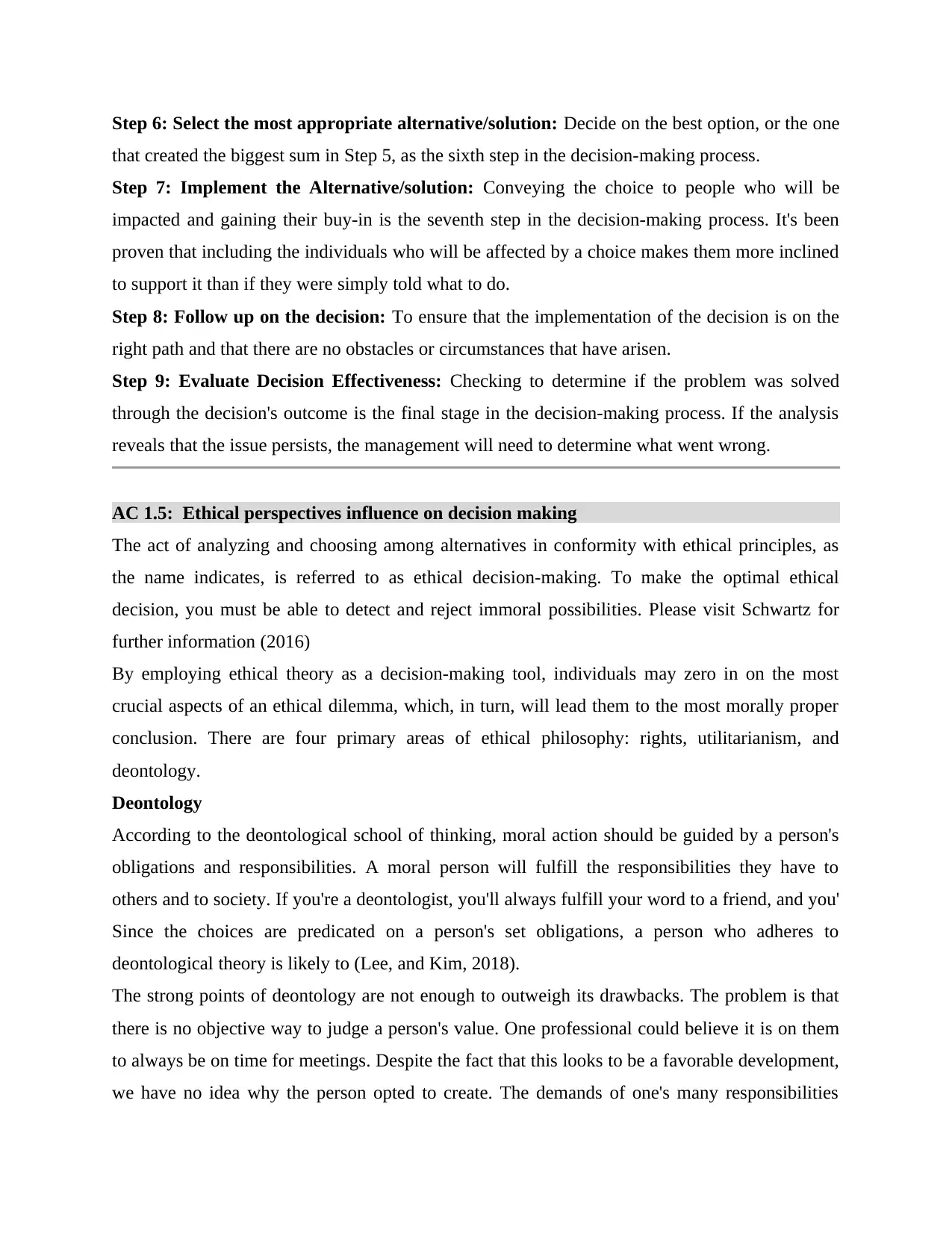
Step 6: Select the most appropriate alternative/solution: Decide on the best option, or the one
that created the biggest sum in Step 5, as the sixth step in the decision-making process.
Step 7: Implement the Alternative/solution: Conveying the choice to people who will be
impacted and gaining their buy-in is the seventh step in the decision-making process. It's been
proven that including the individuals who will be affected by a choice makes them more inclined
to support it than if they were simply told what to do.
Step 8: Follow up on the decision: To ensure that the implementation of the decision is on the
right path and that there are no obstacles or circumstances that have arisen.
Step 9: Evaluate Decision Effectiveness: Checking to determine if the problem was solved
through the decision's outcome is the final stage in the decision-making process. If the analysis
reveals that the issue persists, the management will need to determine what went wrong.
AC 1.5: Ethical perspectives influence on decision making
The act of analyzing and choosing among alternatives in conformity with ethical principles, as
the name indicates, is referred to as ethical decision-making. To make the optimal ethical
decision, you must be able to detect and reject immoral possibilities. Please visit Schwartz for
further information (2016)
By employing ethical theory as a decision-making tool, individuals may zero in on the most
crucial aspects of an ethical dilemma, which, in turn, will lead them to the most morally proper
conclusion. There are four primary areas of ethical philosophy: rights, utilitarianism, and
deontology.
Deontology
According to the deontological school of thinking, moral action should be guided by a person's
obligations and responsibilities. A moral person will fulfill the responsibilities they have to
others and to society. If you're a deontologist, you'll always fulfill your word to a friend, and you'
Since the choices are predicated on a person's set obligations, a person who adheres to
deontological theory is likely to (Lee, and Kim, 2018).
The strong points of deontology are not enough to outweigh its drawbacks. The problem is that
there is no objective way to judge a person's value. One professional could believe it is on them
to always be on time for meetings. Despite the fact that this looks to be a favorable development,
we have no idea why the person opted to create. The demands of one's many responsibilities
that created the biggest sum in Step 5, as the sixth step in the decision-making process.
Step 7: Implement the Alternative/solution: Conveying the choice to people who will be
impacted and gaining their buy-in is the seventh step in the decision-making process. It's been
proven that including the individuals who will be affected by a choice makes them more inclined
to support it than if they were simply told what to do.
Step 8: Follow up on the decision: To ensure that the implementation of the decision is on the
right path and that there are no obstacles or circumstances that have arisen.
Step 9: Evaluate Decision Effectiveness: Checking to determine if the problem was solved
through the decision's outcome is the final stage in the decision-making process. If the analysis
reveals that the issue persists, the management will need to determine what went wrong.
AC 1.5: Ethical perspectives influence on decision making
The act of analyzing and choosing among alternatives in conformity with ethical principles, as
the name indicates, is referred to as ethical decision-making. To make the optimal ethical
decision, you must be able to detect and reject immoral possibilities. Please visit Schwartz for
further information (2016)
By employing ethical theory as a decision-making tool, individuals may zero in on the most
crucial aspects of an ethical dilemma, which, in turn, will lead them to the most morally proper
conclusion. There are four primary areas of ethical philosophy: rights, utilitarianism, and
deontology.
Deontology
According to the deontological school of thinking, moral action should be guided by a person's
obligations and responsibilities. A moral person will fulfill the responsibilities they have to
others and to society. If you're a deontologist, you'll always fulfill your word to a friend, and you'
Since the choices are predicated on a person's set obligations, a person who adheres to
deontological theory is likely to (Lee, and Kim, 2018).
The strong points of deontology are not enough to outweigh its drawbacks. The problem is that
there is no objective way to judge a person's value. One professional could believe it is on them
to always be on time for meetings. Despite the fact that this looks to be a favorable development,
we have no idea why the person opted to create. The demands of one's many responsibilities
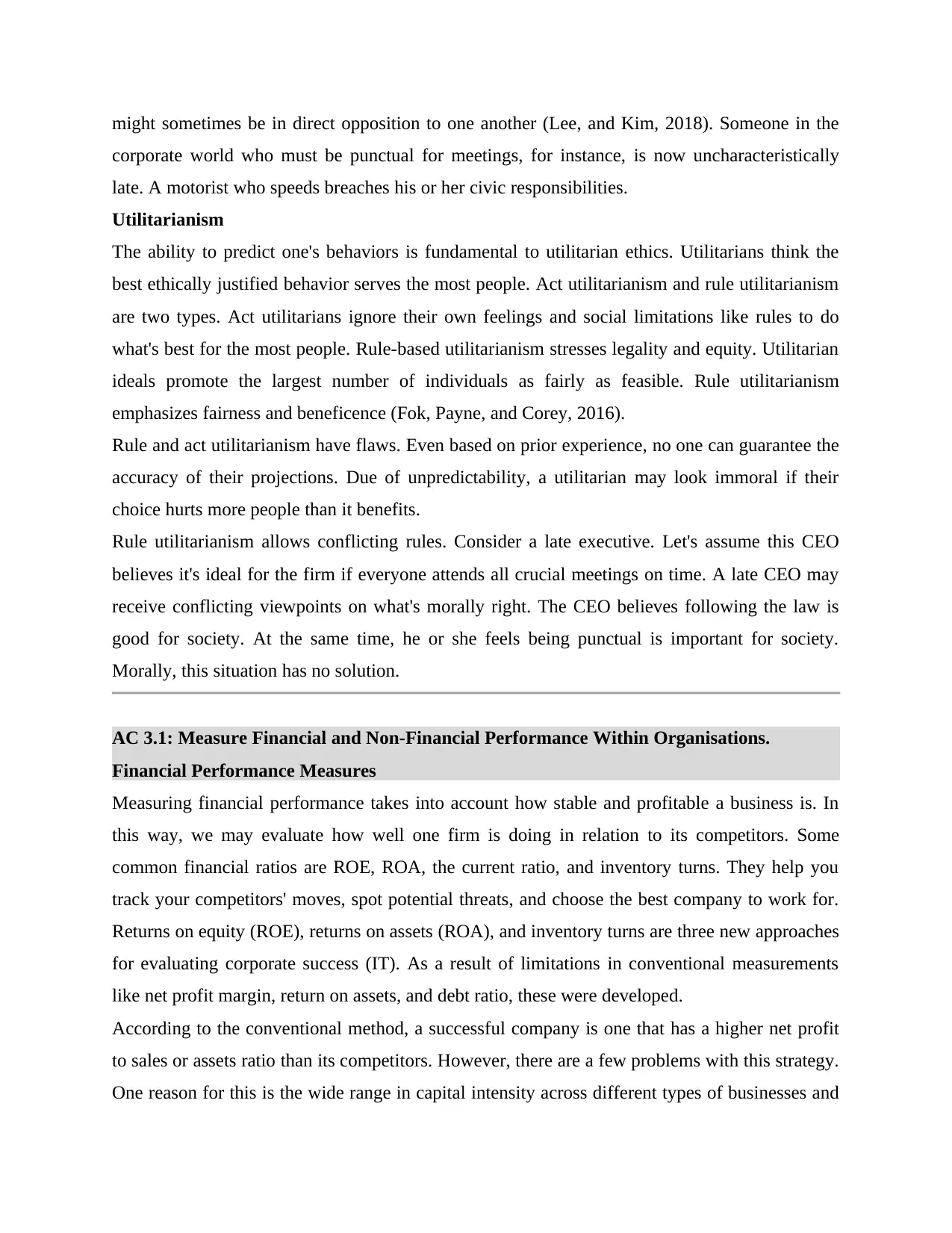
might sometimes be in direct opposition to one another (Lee, and Kim, 2018). Someone in the
corporate world who must be punctual for meetings, for instance, is now uncharacteristically
late. A motorist who speeds breaches his or her civic responsibilities.
Utilitarianism
The ability to predict one's behaviors is fundamental to utilitarian ethics. Utilitarians think the
best ethically justified behavior serves the most people. Act utilitarianism and rule utilitarianism
are two types. Act utilitarians ignore their own feelings and social limitations like rules to do
what's best for the most people. Rule-based utilitarianism stresses legality and equity. Utilitarian
ideals promote the largest number of individuals as fairly as feasible. Rule utilitarianism
emphasizes fairness and beneficence (Fok, Payne, and Corey, 2016).
Rule and act utilitarianism have flaws. Even based on prior experience, no one can guarantee the
accuracy of their projections. Due of unpredictability, a utilitarian may look immoral if their
choice hurts more people than it benefits.
Rule utilitarianism allows conflicting rules. Consider a late executive. Let's assume this CEO
believes it's ideal for the firm if everyone attends all crucial meetings on time. A late CEO may
receive conflicting viewpoints on what's morally right. The CEO believes following the law is
good for society. At the same time, he or she feels being punctual is important for society.
Morally, this situation has no solution.
AC 3.1: Measure Financial and Non-Financial Performance Within Organisations.
Financial Performance Measures
Measuring financial performance takes into account how stable and profitable a business is. In
this way, we may evaluate how well one firm is doing in relation to its competitors. Some
common financial ratios are ROE, ROA, the current ratio, and inventory turns. They help you
track your competitors' moves, spot potential threats, and choose the best company to work for.
Returns on equity (ROE), returns on assets (ROA), and inventory turns are three new approaches
for evaluating corporate success (IT). As a result of limitations in conventional measurements
like net profit margin, return on assets, and debt ratio, these were developed.
According to the conventional method, a successful company is one that has a higher net profit
to sales or assets ratio than its competitors. However, there are a few problems with this strategy.
One reason for this is the wide range in capital intensity across different types of businesses and
corporate world who must be punctual for meetings, for instance, is now uncharacteristically
late. A motorist who speeds breaches his or her civic responsibilities.
Utilitarianism
The ability to predict one's behaviors is fundamental to utilitarian ethics. Utilitarians think the
best ethically justified behavior serves the most people. Act utilitarianism and rule utilitarianism
are two types. Act utilitarians ignore their own feelings and social limitations like rules to do
what's best for the most people. Rule-based utilitarianism stresses legality and equity. Utilitarian
ideals promote the largest number of individuals as fairly as feasible. Rule utilitarianism
emphasizes fairness and beneficence (Fok, Payne, and Corey, 2016).
Rule and act utilitarianism have flaws. Even based on prior experience, no one can guarantee the
accuracy of their projections. Due of unpredictability, a utilitarian may look immoral if their
choice hurts more people than it benefits.
Rule utilitarianism allows conflicting rules. Consider a late executive. Let's assume this CEO
believes it's ideal for the firm if everyone attends all crucial meetings on time. A late CEO may
receive conflicting viewpoints on what's morally right. The CEO believes following the law is
good for society. At the same time, he or she feels being punctual is important for society.
Morally, this situation has no solution.
AC 3.1: Measure Financial and Non-Financial Performance Within Organisations.
Financial Performance Measures
Measuring financial performance takes into account how stable and profitable a business is. In
this way, we may evaluate how well one firm is doing in relation to its competitors. Some
common financial ratios are ROE, ROA, the current ratio, and inventory turns. They help you
track your competitors' moves, spot potential threats, and choose the best company to work for.
Returns on equity (ROE), returns on assets (ROA), and inventory turns are three new approaches
for evaluating corporate success (IT). As a result of limitations in conventional measurements
like net profit margin, return on assets, and debt ratio, these were developed.
According to the conventional method, a successful company is one that has a higher net profit
to sales or assets ratio than its competitors. However, there are a few problems with this strategy.
One reason for this is the wide range in capital intensity across different types of businesses and
Paraphrase This Document
Need a fresh take? Get an instant paraphrase of this document with our AI Paraphraser
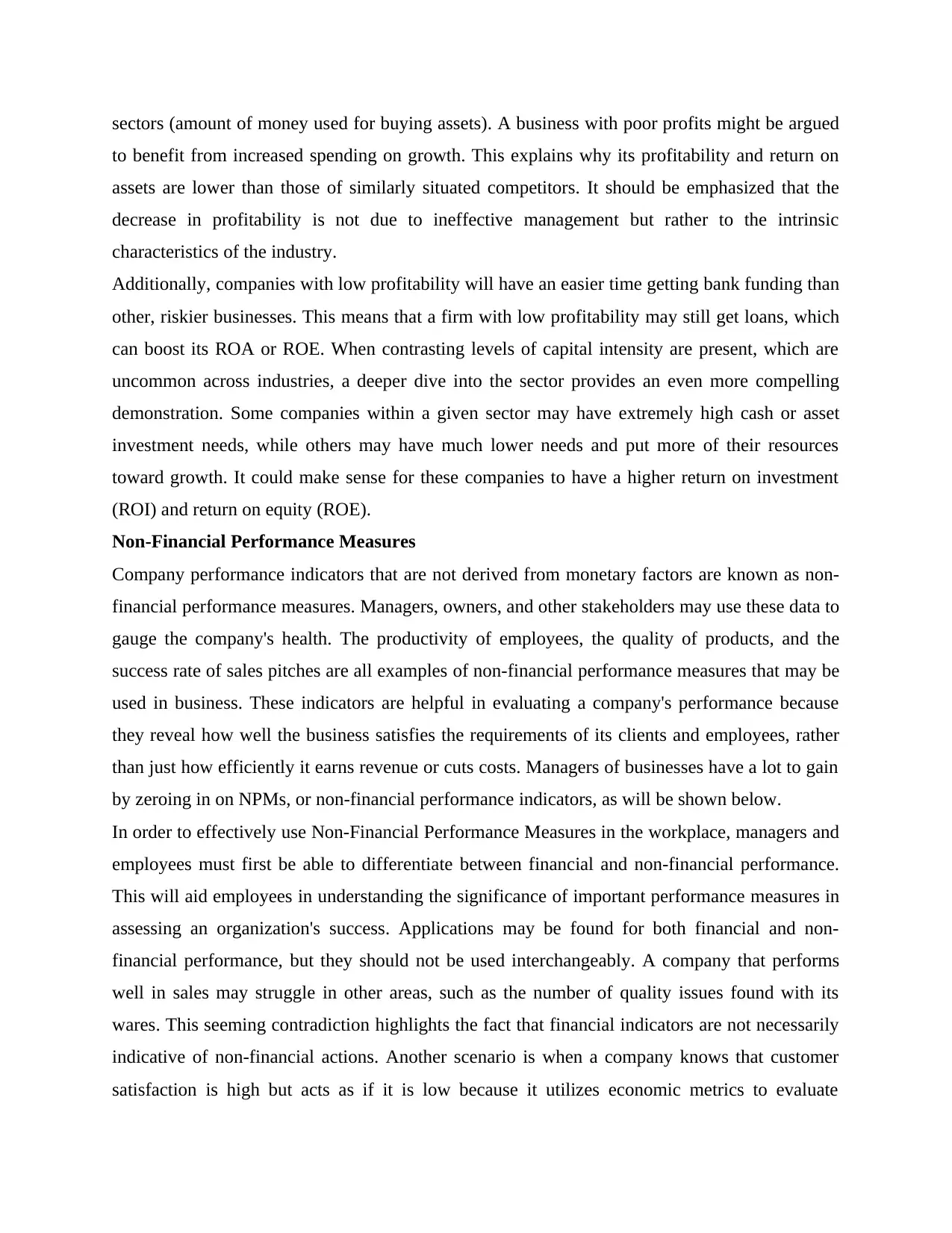
sectors (amount of money used for buying assets). A business with poor profits might be argued
to benefit from increased spending on growth. This explains why its profitability and return on
assets are lower than those of similarly situated competitors. It should be emphasized that the
decrease in profitability is not due to ineffective management but rather to the intrinsic
characteristics of the industry.
Additionally, companies with low profitability will have an easier time getting bank funding than
other, riskier businesses. This means that a firm with low profitability may still get loans, which
can boost its ROA or ROE. When contrasting levels of capital intensity are present, which are
uncommon across industries, a deeper dive into the sector provides an even more compelling
demonstration. Some companies within a given sector may have extremely high cash or asset
investment needs, while others may have much lower needs and put more of their resources
toward growth. It could make sense for these companies to have a higher return on investment
(ROI) and return on equity (ROE).
Non-Financial Performance Measures
Company performance indicators that are not derived from monetary factors are known as non-
financial performance measures. Managers, owners, and other stakeholders may use these data to
gauge the company's health. The productivity of employees, the quality of products, and the
success rate of sales pitches are all examples of non-financial performance measures that may be
used in business. These indicators are helpful in evaluating a company's performance because
they reveal how well the business satisfies the requirements of its clients and employees, rather
than just how efficiently it earns revenue or cuts costs. Managers of businesses have a lot to gain
by zeroing in on NPMs, or non-financial performance indicators, as will be shown below.
In order to effectively use Non-Financial Performance Measures in the workplace, managers and
employees must first be able to differentiate between financial and non-financial performance.
This will aid employees in understanding the significance of important performance measures in
assessing an organization's success. Applications may be found for both financial and non-
financial performance, but they should not be used interchangeably. A company that performs
well in sales may struggle in other areas, such as the number of quality issues found with its
wares. This seeming contradiction highlights the fact that financial indicators are not necessarily
indicative of non-financial actions. Another scenario is when a company knows that customer
satisfaction is high but acts as if it is low because it utilizes economic metrics to evaluate
to benefit from increased spending on growth. This explains why its profitability and return on
assets are lower than those of similarly situated competitors. It should be emphasized that the
decrease in profitability is not due to ineffective management but rather to the intrinsic
characteristics of the industry.
Additionally, companies with low profitability will have an easier time getting bank funding than
other, riskier businesses. This means that a firm with low profitability may still get loans, which
can boost its ROA or ROE. When contrasting levels of capital intensity are present, which are
uncommon across industries, a deeper dive into the sector provides an even more compelling
demonstration. Some companies within a given sector may have extremely high cash or asset
investment needs, while others may have much lower needs and put more of their resources
toward growth. It could make sense for these companies to have a higher return on investment
(ROI) and return on equity (ROE).
Non-Financial Performance Measures
Company performance indicators that are not derived from monetary factors are known as non-
financial performance measures. Managers, owners, and other stakeholders may use these data to
gauge the company's health. The productivity of employees, the quality of products, and the
success rate of sales pitches are all examples of non-financial performance measures that may be
used in business. These indicators are helpful in evaluating a company's performance because
they reveal how well the business satisfies the requirements of its clients and employees, rather
than just how efficiently it earns revenue or cuts costs. Managers of businesses have a lot to gain
by zeroing in on NPMs, or non-financial performance indicators, as will be shown below.
In order to effectively use Non-Financial Performance Measures in the workplace, managers and
employees must first be able to differentiate between financial and non-financial performance.
This will aid employees in understanding the significance of important performance measures in
assessing an organization's success. Applications may be found for both financial and non-
financial performance, but they should not be used interchangeably. A company that performs
well in sales may struggle in other areas, such as the number of quality issues found with its
wares. This seeming contradiction highlights the fact that financial indicators are not necessarily
indicative of non-financial actions. Another scenario is when a company knows that customer
satisfaction is high but acts as if it is low because it utilizes economic metrics to evaluate
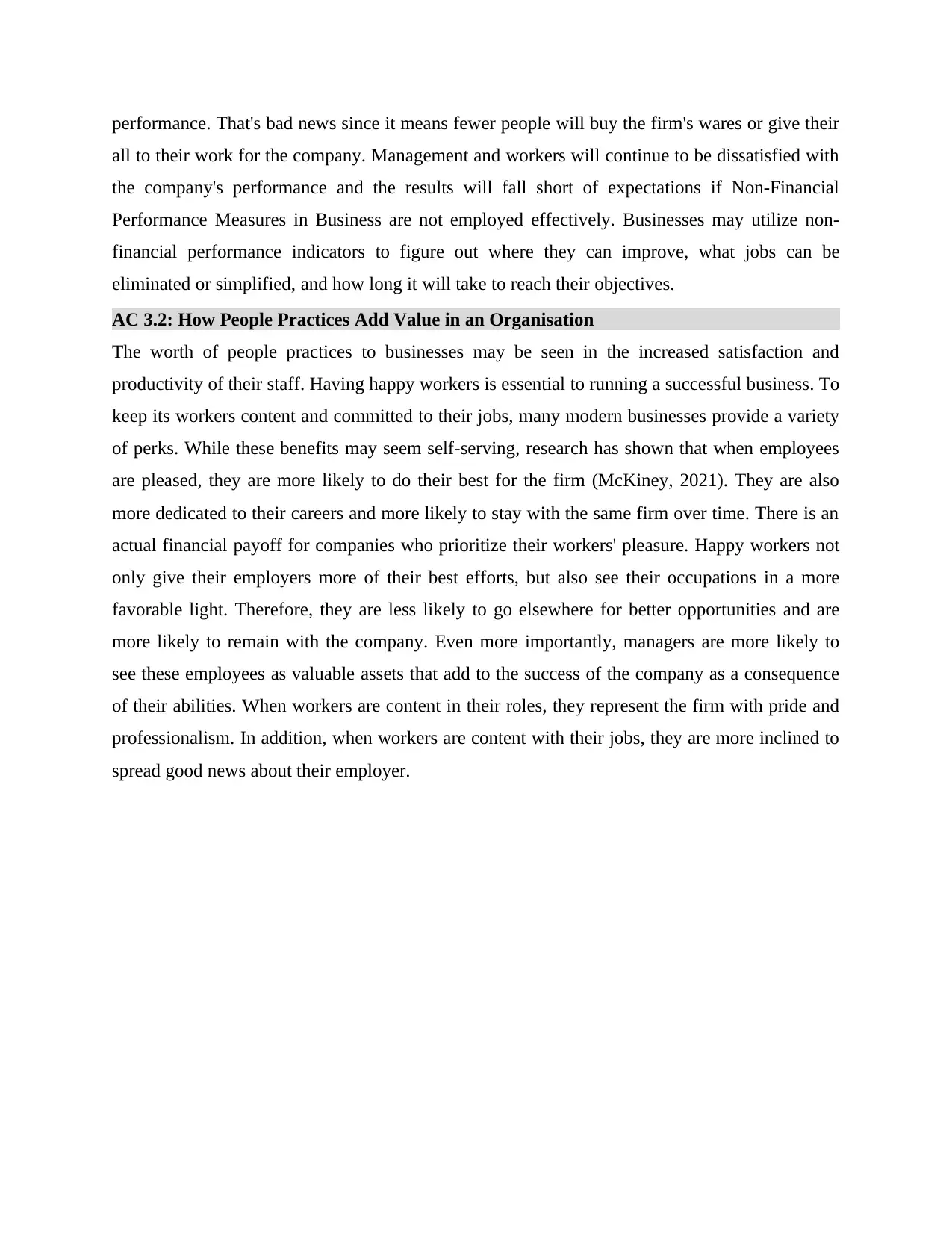
performance. That's bad news since it means fewer people will buy the firm's wares or give their
all to their work for the company. Management and workers will continue to be dissatisfied with
the company's performance and the results will fall short of expectations if Non-Financial
Performance Measures in Business are not employed effectively. Businesses may utilize non-
financial performance indicators to figure out where they can improve, what jobs can be
eliminated or simplified, and how long it will take to reach their objectives.
AC 3.2: How People Practices Add Value in an Organisation
The worth of people practices to businesses may be seen in the increased satisfaction and
productivity of their staff. Having happy workers is essential to running a successful business. To
keep its workers content and committed to their jobs, many modern businesses provide a variety
of perks. While these benefits may seem self-serving, research has shown that when employees
are pleased, they are more likely to do their best for the firm (McKiney, 2021). They are also
more dedicated to their careers and more likely to stay with the same firm over time. There is an
actual financial payoff for companies who prioritize their workers' pleasure. Happy workers not
only give their employers more of their best efforts, but also see their occupations in a more
favorable light. Therefore, they are less likely to go elsewhere for better opportunities and are
more likely to remain with the company. Even more importantly, managers are more likely to
see these employees as valuable assets that add to the success of the company as a consequence
of their abilities. When workers are content in their roles, they represent the firm with pride and
professionalism. In addition, when workers are content with their jobs, they are more inclined to
spread good news about their employer.
all to their work for the company. Management and workers will continue to be dissatisfied with
the company's performance and the results will fall short of expectations if Non-Financial
Performance Measures in Business are not employed effectively. Businesses may utilize non-
financial performance indicators to figure out where they can improve, what jobs can be
eliminated or simplified, and how long it will take to reach their objectives.
AC 3.2: How People Practices Add Value in an Organisation
The worth of people practices to businesses may be seen in the increased satisfaction and
productivity of their staff. Having happy workers is essential to running a successful business. To
keep its workers content and committed to their jobs, many modern businesses provide a variety
of perks. While these benefits may seem self-serving, research has shown that when employees
are pleased, they are more likely to do their best for the firm (McKiney, 2021). They are also
more dedicated to their careers and more likely to stay with the same firm over time. There is an
actual financial payoff for companies who prioritize their workers' pleasure. Happy workers not
only give their employers more of their best efforts, but also see their occupations in a more
favorable light. Therefore, they are less likely to go elsewhere for better opportunities and are
more likely to remain with the company. Even more importantly, managers are more likely to
see these employees as valuable assets that add to the success of the company as a consequence
of their abilities. When workers are content in their roles, they represent the firm with pride and
professionalism. In addition, when workers are content with their jobs, they are more inclined to
spread good news about their employer.
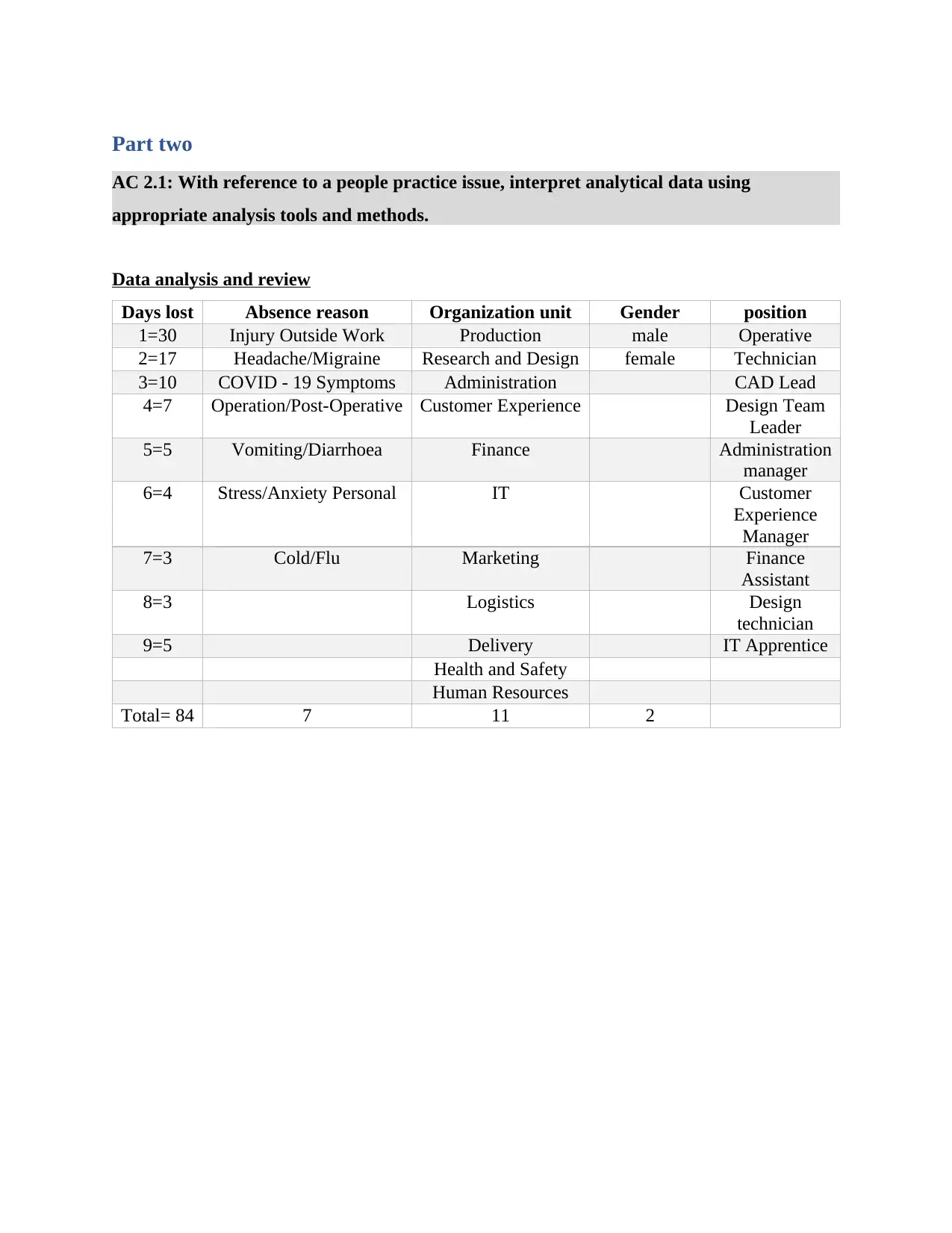
Part two
AC 2.1: With reference to a people practice issue, interpret analytical data using
appropriate analysis tools and methods.
Data analysis and review
Days lost Absence reason Organization unit Gender position
1=30 Injury Outside Work Production male Operative
2=17 Headache/Migraine Research and Design female Technician
3=10 COVID - 19 Symptoms Administration CAD Lead
4=7 Operation/Post-Operative Customer Experience Design Team
Leader
5=5 Vomiting/Diarrhoea Finance Administration
manager
6=4 Stress/Anxiety Personal IT Customer
Experience
Manager
7=3 Cold/Flu Marketing Finance
Assistant
8=3 Logistics Design
technician
9=5 Delivery IT Apprentice
Health and Safety
Human Resources
Total= 84 7 11 2
AC 2.1: With reference to a people practice issue, interpret analytical data using
appropriate analysis tools and methods.
Data analysis and review
Days lost Absence reason Organization unit Gender position
1=30 Injury Outside Work Production male Operative
2=17 Headache/Migraine Research and Design female Technician
3=10 COVID - 19 Symptoms Administration CAD Lead
4=7 Operation/Post-Operative Customer Experience Design Team
Leader
5=5 Vomiting/Diarrhoea Finance Administration
manager
6=4 Stress/Anxiety Personal IT Customer
Experience
Manager
7=3 Cold/Flu Marketing Finance
Assistant
8=3 Logistics Design
technician
9=5 Delivery IT Apprentice
Health and Safety
Human Resources
Total= 84 7 11 2
Secure Best Marks with AI Grader
Need help grading? Try our AI Grader for instant feedback on your assignments.
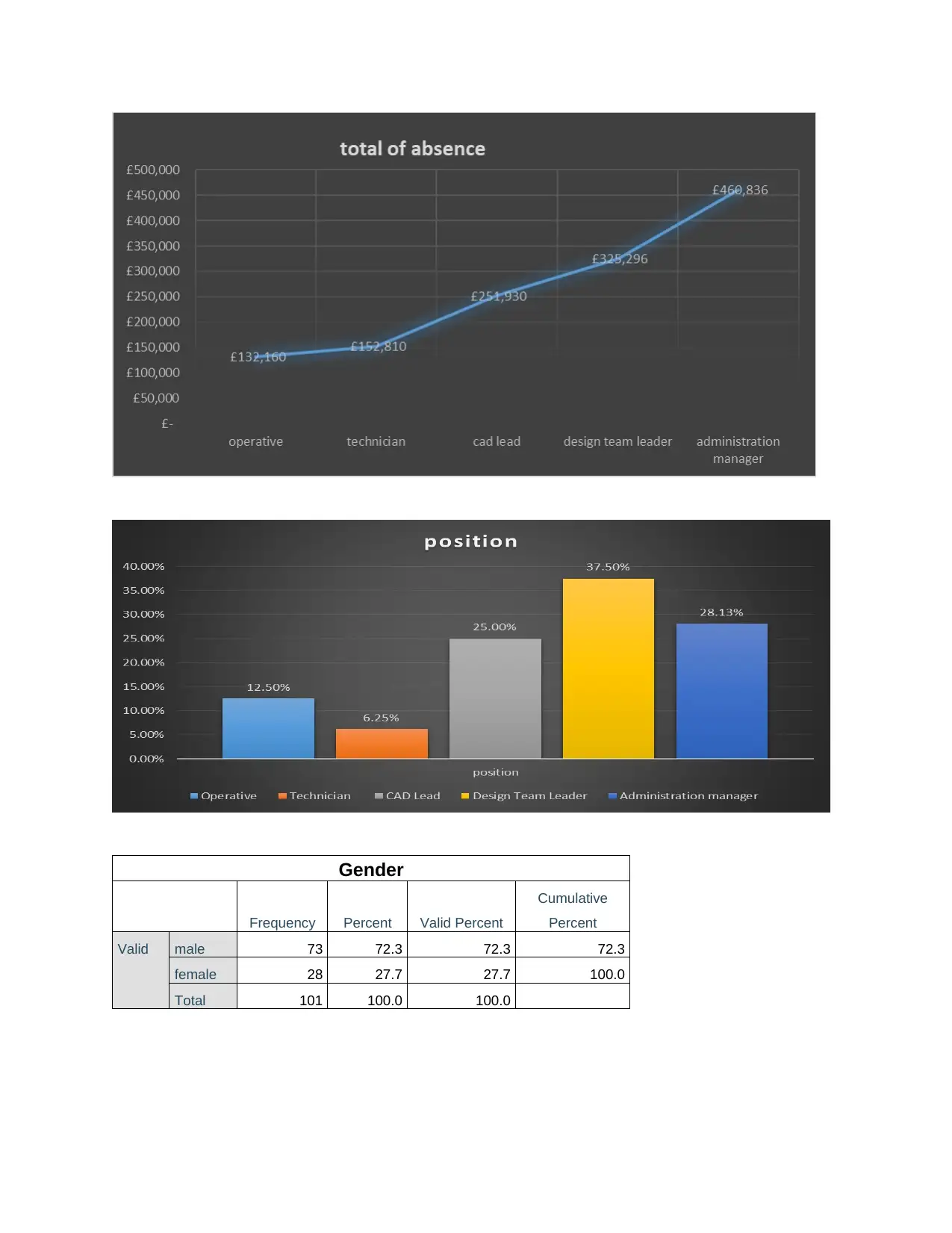
Gender
Frequency Percent Valid Percent
Cumulative
Percent
Valid male 73 72.3 72.3 72.3
female 28 27.7 27.7 100.0
Total 101 100.0 100.0
Frequency Percent Valid Percent
Cumulative
Percent
Valid male 73 72.3 72.3 72.3
female 28 27.7 27.7 100.0
Total 101 100.0 100.0
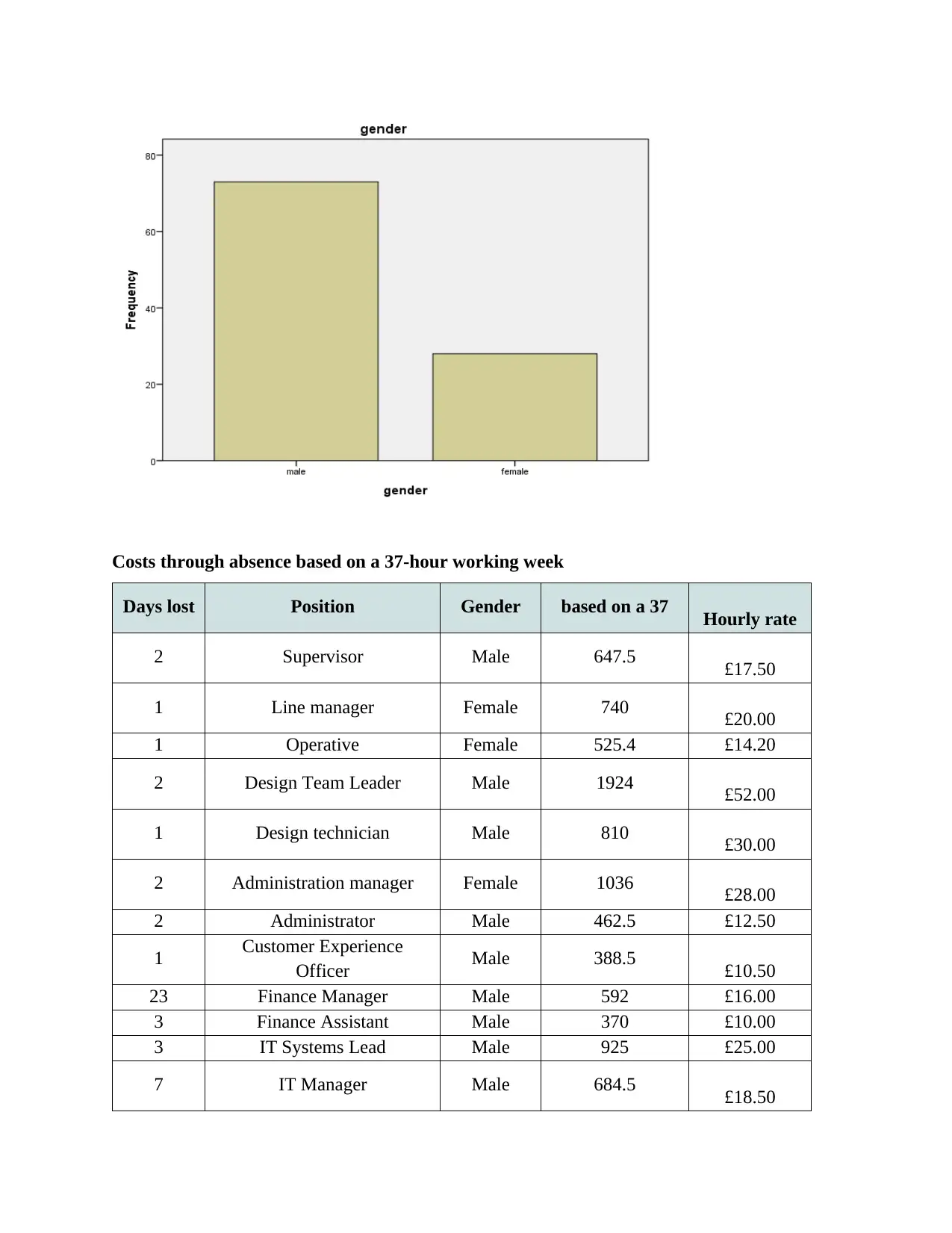
Costs through absence based on a 37-hour working week
Days lost Position Gender based on a 37 Hourly rate
2 Supervisor Male 647.5 £17.50
1 Line manager Female 740 £20.00
1 Operative Female 525.4 £14.20
2 Design Team Leader Male 1924 £52.00
1 Design technician Male 810 £30.00
2 Administration manager Female 1036 £28.00
2 Administrator Male 462.5 £12.50
1 Customer Experience
Officer Male 388.5 £10.50
23 Finance Manager Male 592 £16.00
3 Finance Assistant Male 370 £10.00
3 IT Systems Lead Male 925 £25.00
7 IT Manager Male 684.5 £18.50
Days lost Position Gender based on a 37 Hourly rate
2 Supervisor Male 647.5 £17.50
1 Line manager Female 740 £20.00
1 Operative Female 525.4 £14.20
2 Design Team Leader Male 1924 £52.00
1 Design technician Male 810 £30.00
2 Administration manager Female 1036 £28.00
2 Administrator Male 462.5 £12.50
1 Customer Experience
Officer Male 388.5 £10.50
23 Finance Manager Male 592 £16.00
3 Finance Assistant Male 370 £10.00
3 IT Systems Lead Male 925 £25.00
7 IT Manager Male 684.5 £18.50
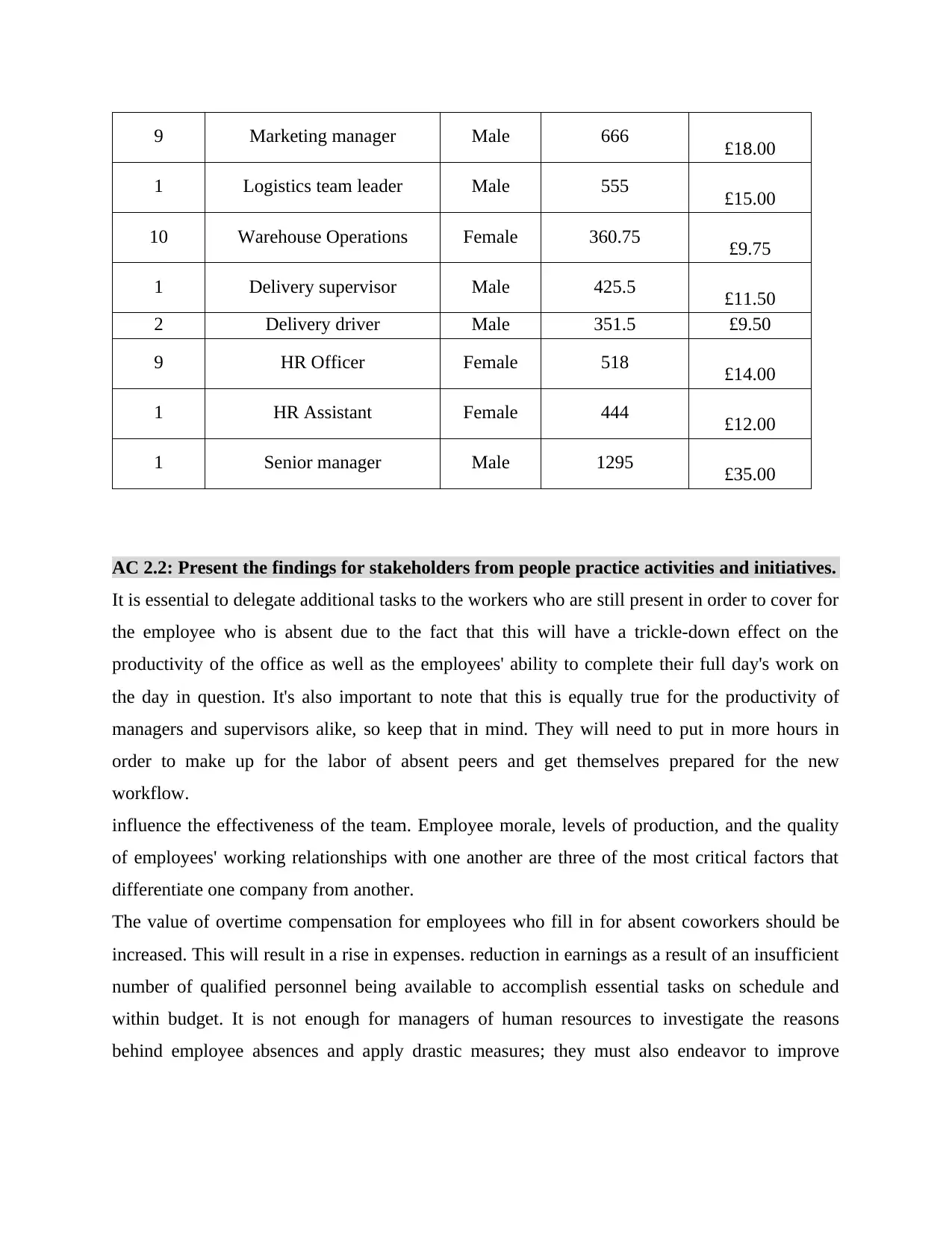
9 Marketing manager Male 666 £18.00
1 Logistics team leader Male 555 £15.00
10 Warehouse Operations Female 360.75 £9.75
1 Delivery supervisor Male 425.5 £11.50
2 Delivery driver Male 351.5 £9.50
9 HR Officer Female 518 £14.00
1 HR Assistant Female 444 £12.00
1 Senior manager Male 1295 £35.00
AC 2.2: Present the findings for stakeholders from people practice activities and initiatives.
It is essential to delegate additional tasks to the workers who are still present in order to cover for
the employee who is absent due to the fact that this will have a trickle-down effect on the
productivity of the office as well as the employees' ability to complete their full day's work on
the day in question. It's also important to note that this is equally true for the productivity of
managers and supervisors alike, so keep that in mind. They will need to put in more hours in
order to make up for the labor of absent peers and get themselves prepared for the new
workflow.
influence the effectiveness of the team. Employee morale, levels of production, and the quality
of employees' working relationships with one another are three of the most critical factors that
differentiate one company from another.
The value of overtime compensation for employees who fill in for absent coworkers should be
increased. This will result in a rise in expenses. reduction in earnings as a result of an insufficient
number of qualified personnel being available to accomplish essential tasks on schedule and
within budget. It is not enough for managers of human resources to investigate the reasons
behind employee absences and apply drastic measures; they must also endeavor to improve
1 Logistics team leader Male 555 £15.00
10 Warehouse Operations Female 360.75 £9.75
1 Delivery supervisor Male 425.5 £11.50
2 Delivery driver Male 351.5 £9.50
9 HR Officer Female 518 £14.00
1 HR Assistant Female 444 £12.00
1 Senior manager Male 1295 £35.00
AC 2.2: Present the findings for stakeholders from people practice activities and initiatives.
It is essential to delegate additional tasks to the workers who are still present in order to cover for
the employee who is absent due to the fact that this will have a trickle-down effect on the
productivity of the office as well as the employees' ability to complete their full day's work on
the day in question. It's also important to note that this is equally true for the productivity of
managers and supervisors alike, so keep that in mind. They will need to put in more hours in
order to make up for the labor of absent peers and get themselves prepared for the new
workflow.
influence the effectiveness of the team. Employee morale, levels of production, and the quality
of employees' working relationships with one another are three of the most critical factors that
differentiate one company from another.
The value of overtime compensation for employees who fill in for absent coworkers should be
increased. This will result in a rise in expenses. reduction in earnings as a result of an insufficient
number of qualified personnel being available to accomplish essential tasks on schedule and
within budget. It is not enough for managers of human resources to investigate the reasons
behind employee absences and apply drastic measures; they must also endeavor to improve
Paraphrase This Document
Need a fresh take? Get an instant paraphrase of this document with our AI Paraphraser
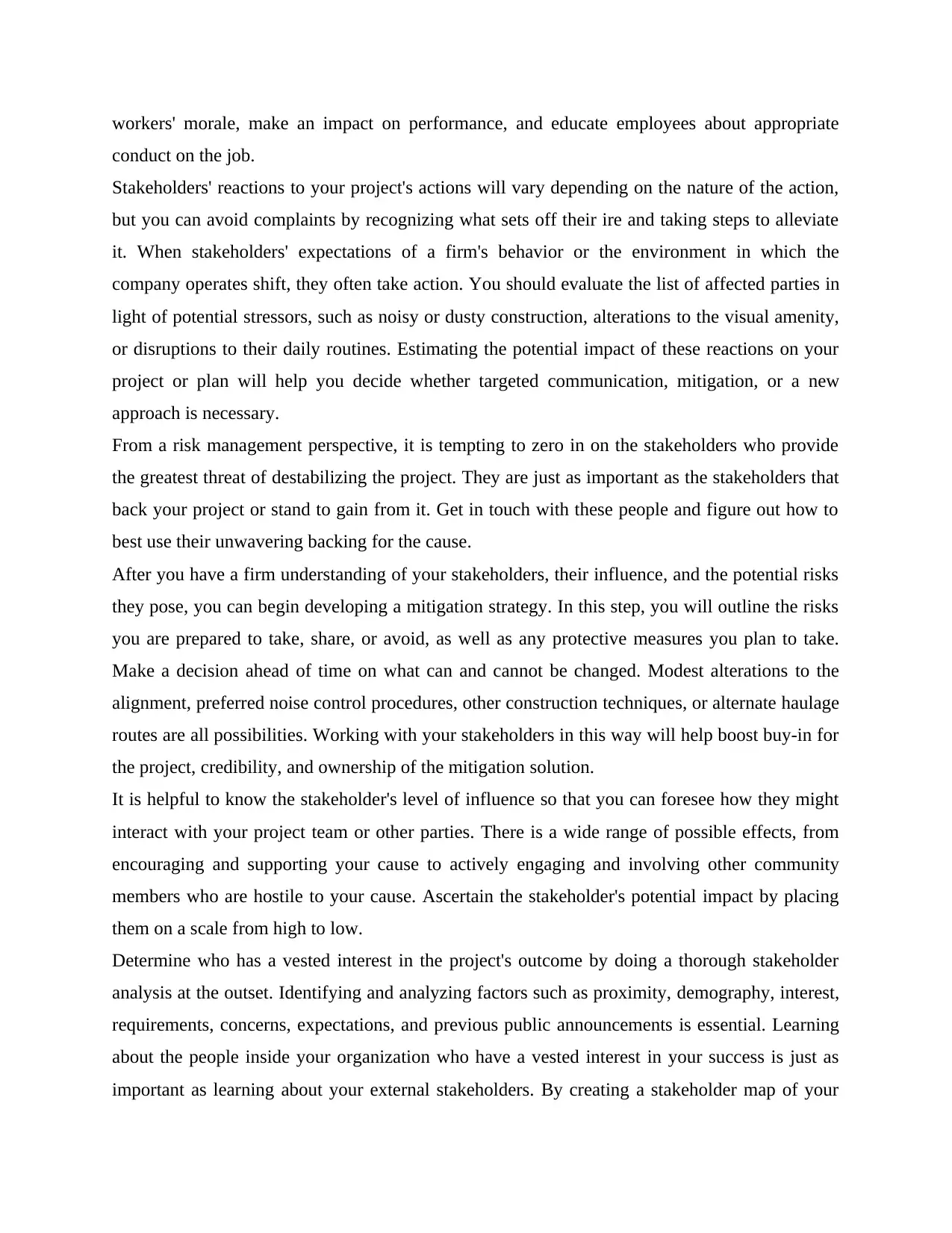
workers' morale, make an impact on performance, and educate employees about appropriate
conduct on the job.
Stakeholders' reactions to your project's actions will vary depending on the nature of the action,
but you can avoid complaints by recognizing what sets off their ire and taking steps to alleviate
it. When stakeholders' expectations of a firm's behavior or the environment in which the
company operates shift, they often take action. You should evaluate the list of affected parties in
light of potential stressors, such as noisy or dusty construction, alterations to the visual amenity,
or disruptions to their daily routines. Estimating the potential impact of these reactions on your
project or plan will help you decide whether targeted communication, mitigation, or a new
approach is necessary.
From a risk management perspective, it is tempting to zero in on the stakeholders who provide
the greatest threat of destabilizing the project. They are just as important as the stakeholders that
back your project or stand to gain from it. Get in touch with these people and figure out how to
best use their unwavering backing for the cause.
After you have a firm understanding of your stakeholders, their influence, and the potential risks
they pose, you can begin developing a mitigation strategy. In this step, you will outline the risks
you are prepared to take, share, or avoid, as well as any protective measures you plan to take.
Make a decision ahead of time on what can and cannot be changed. Modest alterations to the
alignment, preferred noise control procedures, other construction techniques, or alternate haulage
routes are all possibilities. Working with your stakeholders in this way will help boost buy-in for
the project, credibility, and ownership of the mitigation solution.
It is helpful to know the stakeholder's level of influence so that you can foresee how they might
interact with your project team or other parties. There is a wide range of possible effects, from
encouraging and supporting your cause to actively engaging and involving other community
members who are hostile to your cause. Ascertain the stakeholder's potential impact by placing
them on a scale from high to low.
Determine who has a vested interest in the project's outcome by doing a thorough stakeholder
analysis at the outset. Identifying and analyzing factors such as proximity, demography, interest,
requirements, concerns, expectations, and previous public announcements is essential. Learning
about the people inside your organization who have a vested interest in your success is just as
important as learning about your external stakeholders. By creating a stakeholder map of your
conduct on the job.
Stakeholders' reactions to your project's actions will vary depending on the nature of the action,
but you can avoid complaints by recognizing what sets off their ire and taking steps to alleviate
it. When stakeholders' expectations of a firm's behavior or the environment in which the
company operates shift, they often take action. You should evaluate the list of affected parties in
light of potential stressors, such as noisy or dusty construction, alterations to the visual amenity,
or disruptions to their daily routines. Estimating the potential impact of these reactions on your
project or plan will help you decide whether targeted communication, mitigation, or a new
approach is necessary.
From a risk management perspective, it is tempting to zero in on the stakeholders who provide
the greatest threat of destabilizing the project. They are just as important as the stakeholders that
back your project or stand to gain from it. Get in touch with these people and figure out how to
best use their unwavering backing for the cause.
After you have a firm understanding of your stakeholders, their influence, and the potential risks
they pose, you can begin developing a mitigation strategy. In this step, you will outline the risks
you are prepared to take, share, or avoid, as well as any protective measures you plan to take.
Make a decision ahead of time on what can and cannot be changed. Modest alterations to the
alignment, preferred noise control procedures, other construction techniques, or alternate haulage
routes are all possibilities. Working with your stakeholders in this way will help boost buy-in for
the project, credibility, and ownership of the mitigation solution.
It is helpful to know the stakeholder's level of influence so that you can foresee how they might
interact with your project team or other parties. There is a wide range of possible effects, from
encouraging and supporting your cause to actively engaging and involving other community
members who are hostile to your cause. Ascertain the stakeholder's potential impact by placing
them on a scale from high to low.
Determine who has a vested interest in the project's outcome by doing a thorough stakeholder
analysis at the outset. Identifying and analyzing factors such as proximity, demography, interest,
requirements, concerns, expectations, and previous public announcements is essential. Learning
about the people inside your organization who have a vested interest in your success is just as
important as learning about your external stakeholders. By creating a stakeholder map of your
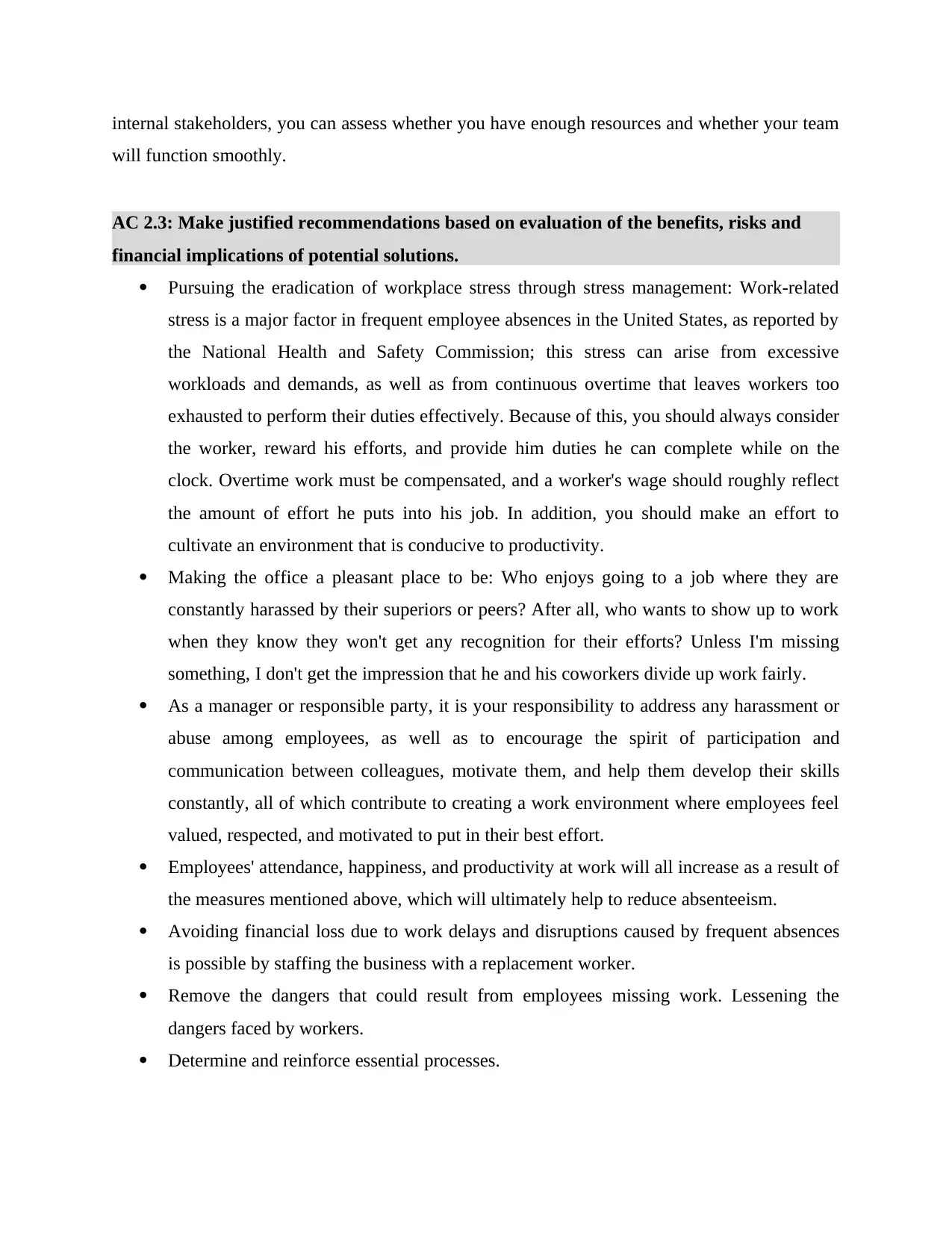
internal stakeholders, you can assess whether you have enough resources and whether your team
will function smoothly.
AC 2.3: Make justified recommendations based on evaluation of the benefits, risks and
financial implications of potential solutions.
Pursuing the eradication of workplace stress through stress management: Work-related
stress is a major factor in frequent employee absences in the United States, as reported by
the National Health and Safety Commission; this stress can arise from excessive
workloads and demands, as well as from continuous overtime that leaves workers too
exhausted to perform their duties effectively. Because of this, you should always consider
the worker, reward his efforts, and provide him duties he can complete while on the
clock. Overtime work must be compensated, and a worker's wage should roughly reflect
the amount of effort he puts into his job. In addition, you should make an effort to
cultivate an environment that is conducive to productivity.
Making the office a pleasant place to be: Who enjoys going to a job where they are
constantly harassed by their superiors or peers? After all, who wants to show up to work
when they know they won't get any recognition for their efforts? Unless I'm missing
something, I don't get the impression that he and his coworkers divide up work fairly.
As a manager or responsible party, it is your responsibility to address any harassment or
abuse among employees, as well as to encourage the spirit of participation and
communication between colleagues, motivate them, and help them develop their skills
constantly, all of which contribute to creating a work environment where employees feel
valued, respected, and motivated to put in their best effort.
Employees' attendance, happiness, and productivity at work will all increase as a result of
the measures mentioned above, which will ultimately help to reduce absenteeism.
Avoiding financial loss due to work delays and disruptions caused by frequent absences
is possible by staffing the business with a replacement worker.
Remove the dangers that could result from employees missing work. Lessening the
dangers faced by workers.
Determine and reinforce essential processes.
will function smoothly.
AC 2.3: Make justified recommendations based on evaluation of the benefits, risks and
financial implications of potential solutions.
Pursuing the eradication of workplace stress through stress management: Work-related
stress is a major factor in frequent employee absences in the United States, as reported by
the National Health and Safety Commission; this stress can arise from excessive
workloads and demands, as well as from continuous overtime that leaves workers too
exhausted to perform their duties effectively. Because of this, you should always consider
the worker, reward his efforts, and provide him duties he can complete while on the
clock. Overtime work must be compensated, and a worker's wage should roughly reflect
the amount of effort he puts into his job. In addition, you should make an effort to
cultivate an environment that is conducive to productivity.
Making the office a pleasant place to be: Who enjoys going to a job where they are
constantly harassed by their superiors or peers? After all, who wants to show up to work
when they know they won't get any recognition for their efforts? Unless I'm missing
something, I don't get the impression that he and his coworkers divide up work fairly.
As a manager or responsible party, it is your responsibility to address any harassment or
abuse among employees, as well as to encourage the spirit of participation and
communication between colleagues, motivate them, and help them develop their skills
constantly, all of which contribute to creating a work environment where employees feel
valued, respected, and motivated to put in their best effort.
Employees' attendance, happiness, and productivity at work will all increase as a result of
the measures mentioned above, which will ultimately help to reduce absenteeism.
Avoiding financial loss due to work delays and disruptions caused by frequent absences
is possible by staffing the business with a replacement worker.
Remove the dangers that could result from employees missing work. Lessening the
dangers faced by workers.
Determine and reinforce essential processes.
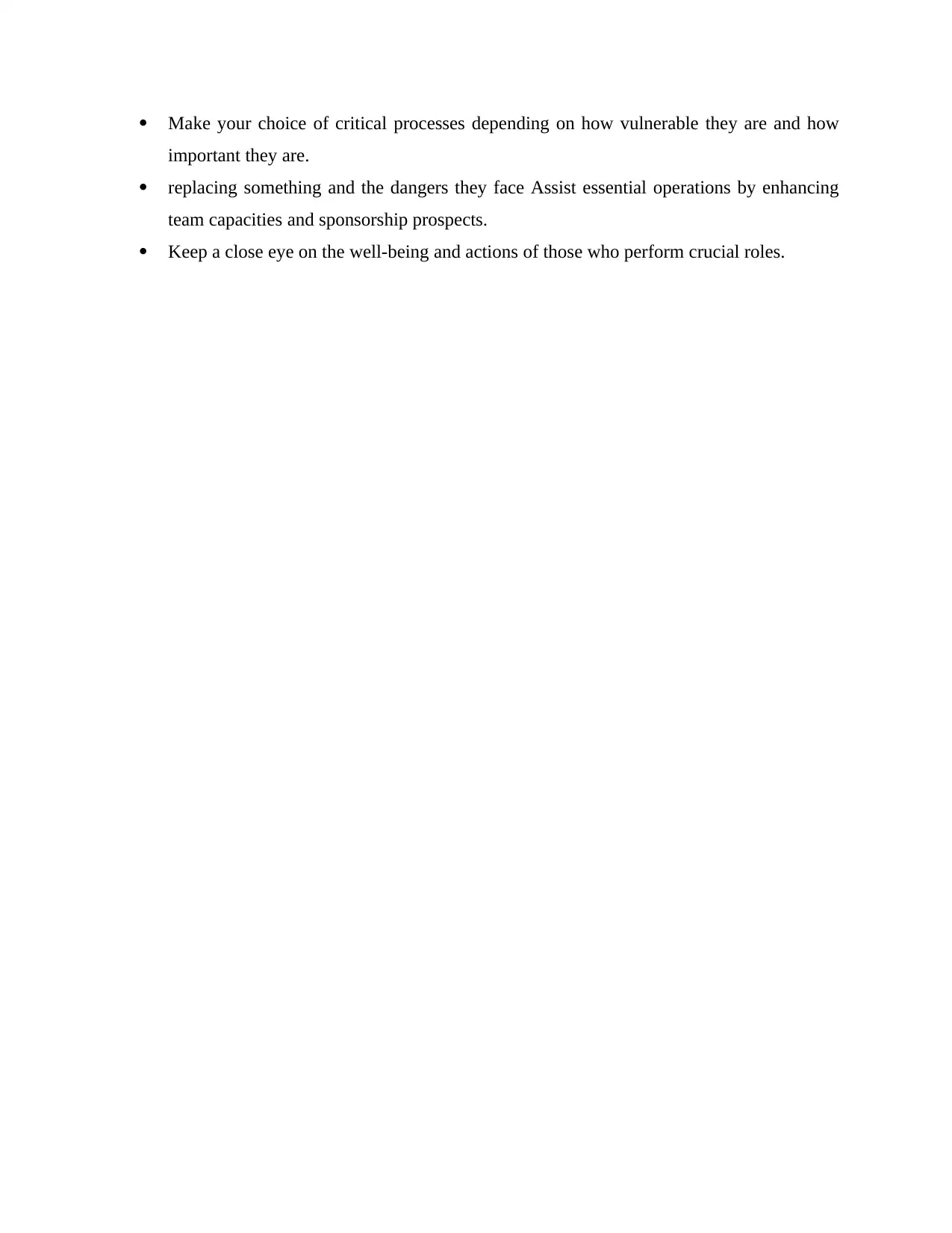
Make your choice of critical processes depending on how vulnerable they are and how
important they are.
replacing something and the dangers they face Assist essential operations by enhancing
team capacities and sponsorship prospects.
Keep a close eye on the well-being and actions of those who perform crucial roles.
important they are.
replacing something and the dangers they face Assist essential operations by enhancing
team capacities and sponsorship prospects.
Keep a close eye on the well-being and actions of those who perform crucial roles.
Secure Best Marks with AI Grader
Need help grading? Try our AI Grader for instant feedback on your assignments.
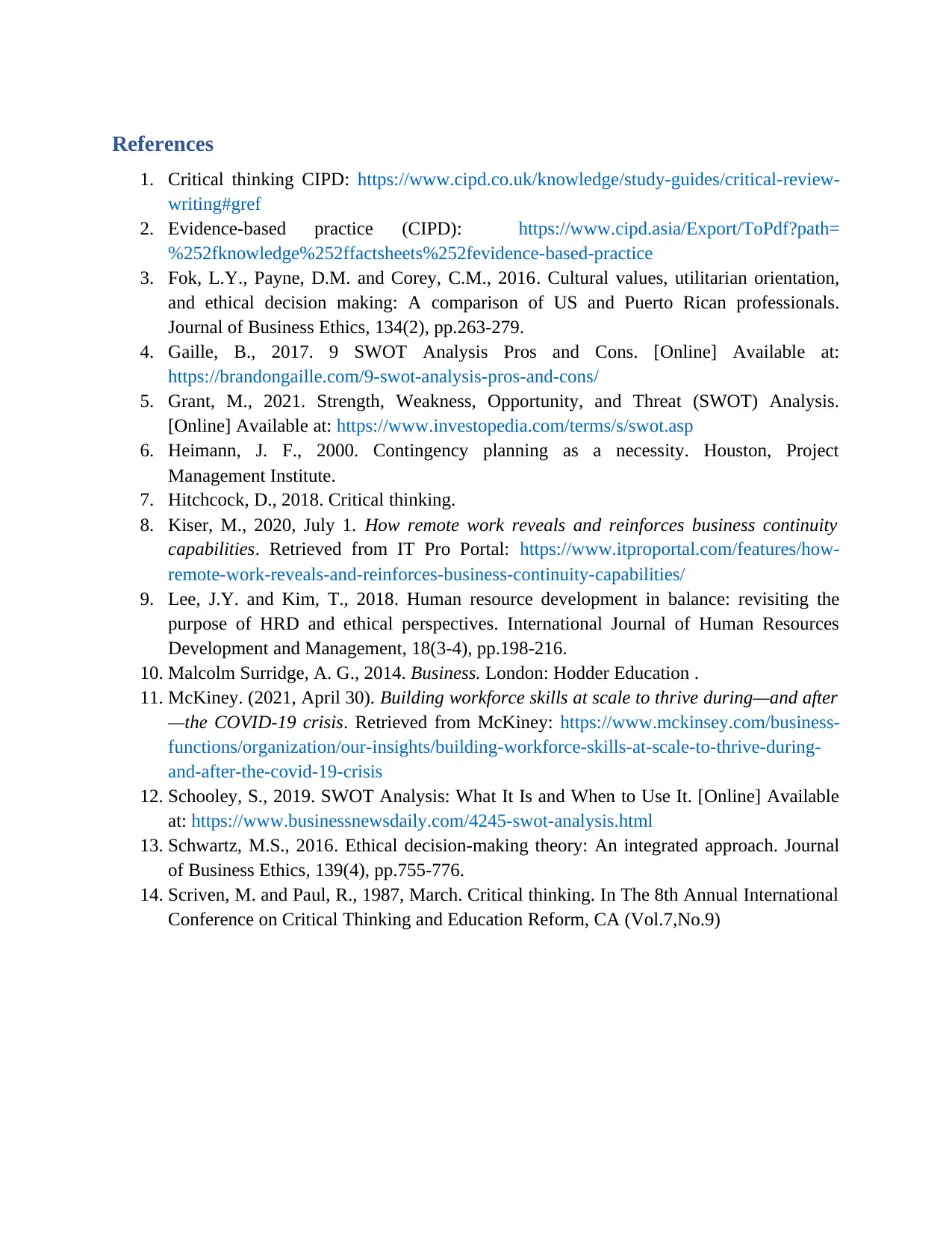
References
1. Critical thinking CIPD: https://www.cipd.co.uk/knowledge/study-guides/critical-review-
writing#gref
2. Evidence-based practice (CIPD): https://www.cipd.asia/Export/ToPdf?path=
%252fknowledge%252ffactsheets%252fevidence-based-practice
3. Fok, L.Y., Payne, D.M. and Corey, C.M., 2016. Cultural values, utilitarian orientation,
and ethical decision making: A comparison of US and Puerto Rican professionals.
Journal of Business Ethics, 134(2), pp.263-279.
4. Gaille, B., 2017. 9 SWOT Analysis Pros and Cons. [Online] Available at:
https://brandongaille.com/9-swot-analysis-pros-and-cons/
5. Grant, M., 2021. Strength, Weakness, Opportunity, and Threat (SWOT) Analysis.
[Online] Available at: https://www.investopedia.com/terms/s/swot.asp
6. Heimann, J. F., 2000. Contingency planning as a necessity. Houston, Project
Management Institute.
7. Hitchcock, D., 2018. Critical thinking.
8. Kiser, M., 2020, July 1. How remote work reveals and reinforces business continuity
capabilities. Retrieved from IT Pro Portal: https://www.itproportal.com/features/how-
remote-work-reveals-and-reinforces-business-continuity-capabilities/
9. Lee, J.Y. and Kim, T., 2018. Human resource development in balance: revisiting the
purpose of HRD and ethical perspectives. International Journal of Human Resources
Development and Management, 18(3-4), pp.198-216.
10. Malcolm Surridge, A. G., 2014. Business. London: Hodder Education .
11. McKiney. (2021, April 30). Building workforce skills at scale to thrive during—and after
—the COVID-19 crisis. Retrieved from McKiney: https://www.mckinsey.com/business-
functions/organization/our-insights/building-workforce-skills-at-scale-to-thrive-during-
and-after-the-covid-19-crisis
12. Schooley, S., 2019. SWOT Analysis: What It Is and When to Use It. [Online] Available
at: https://www.businessnewsdaily.com/4245-swot-analysis.html
13. Schwartz, M.S., 2016. Ethical decision-making theory: An integrated approach. Journal
of Business Ethics, 139(4), pp.755-776.
14. Scriven, M. and Paul, R., 1987, March. Critical thinking. In The 8th Annual International
Conference on Critical Thinking and Education Reform, CA (Vol.7,No.9)
1. Critical thinking CIPD: https://www.cipd.co.uk/knowledge/study-guides/critical-review-
writing#gref
2. Evidence-based practice (CIPD): https://www.cipd.asia/Export/ToPdf?path=
%252fknowledge%252ffactsheets%252fevidence-based-practice
3. Fok, L.Y., Payne, D.M. and Corey, C.M., 2016. Cultural values, utilitarian orientation,
and ethical decision making: A comparison of US and Puerto Rican professionals.
Journal of Business Ethics, 134(2), pp.263-279.
4. Gaille, B., 2017. 9 SWOT Analysis Pros and Cons. [Online] Available at:
https://brandongaille.com/9-swot-analysis-pros-and-cons/
5. Grant, M., 2021. Strength, Weakness, Opportunity, and Threat (SWOT) Analysis.
[Online] Available at: https://www.investopedia.com/terms/s/swot.asp
6. Heimann, J. F., 2000. Contingency planning as a necessity. Houston, Project
Management Institute.
7. Hitchcock, D., 2018. Critical thinking.
8. Kiser, M., 2020, July 1. How remote work reveals and reinforces business continuity
capabilities. Retrieved from IT Pro Portal: https://www.itproportal.com/features/how-
remote-work-reveals-and-reinforces-business-continuity-capabilities/
9. Lee, J.Y. and Kim, T., 2018. Human resource development in balance: revisiting the
purpose of HRD and ethical perspectives. International Journal of Human Resources
Development and Management, 18(3-4), pp.198-216.
10. Malcolm Surridge, A. G., 2014. Business. London: Hodder Education .
11. McKiney. (2021, April 30). Building workforce skills at scale to thrive during—and after
—the COVID-19 crisis. Retrieved from McKiney: https://www.mckinsey.com/business-
functions/organization/our-insights/building-workforce-skills-at-scale-to-thrive-during-
and-after-the-covid-19-crisis
12. Schooley, S., 2019. SWOT Analysis: What It Is and When to Use It. [Online] Available
at: https://www.businessnewsdaily.com/4245-swot-analysis.html
13. Schwartz, M.S., 2016. Ethical decision-making theory: An integrated approach. Journal
of Business Ethics, 139(4), pp.755-776.
14. Scriven, M. and Paul, R., 1987, March. Critical thinking. In The 8th Annual International
Conference on Critical Thinking and Education Reform, CA (Vol.7,No.9)
1 out of 17
Related Documents
Your All-in-One AI-Powered Toolkit for Academic Success.
+13062052269
info@desklib.com
Available 24*7 on WhatsApp / Email
![[object Object]](/_next/static/media/star-bottom.7253800d.svg)
Unlock your academic potential
© 2024 | Zucol Services PVT LTD | All rights reserved.





